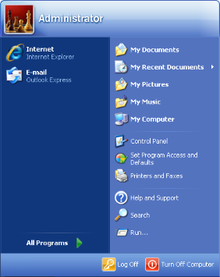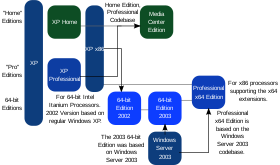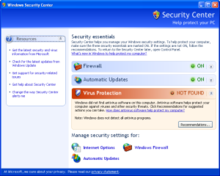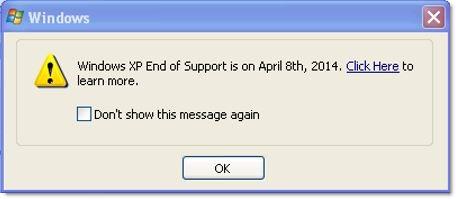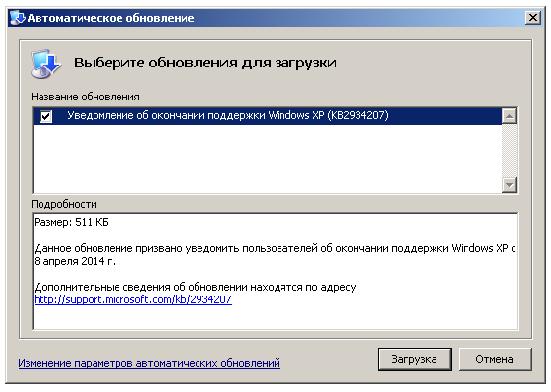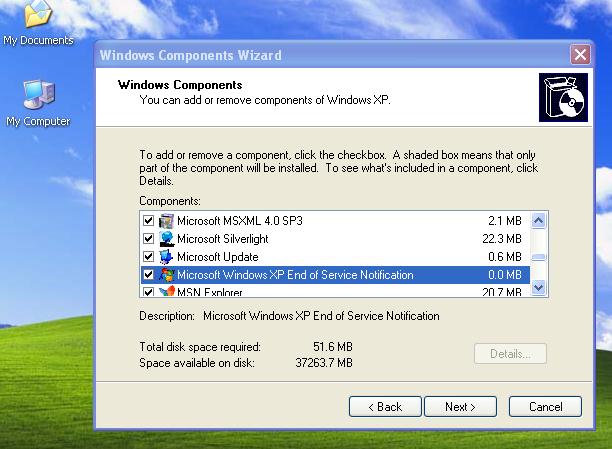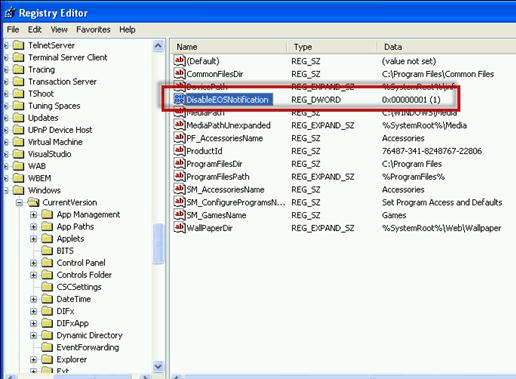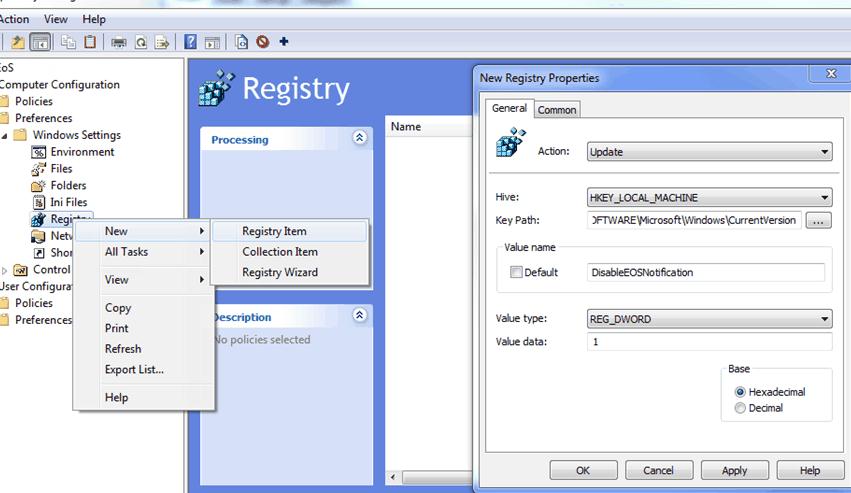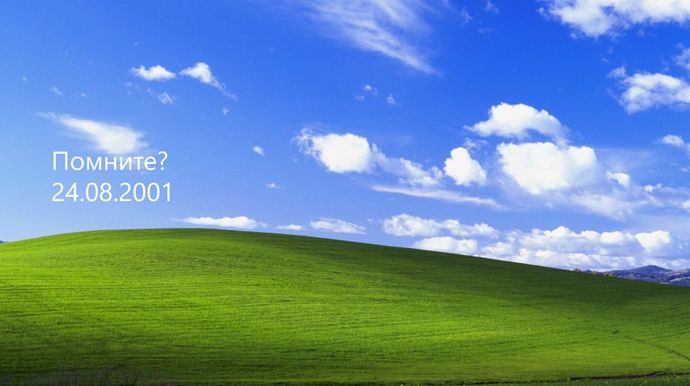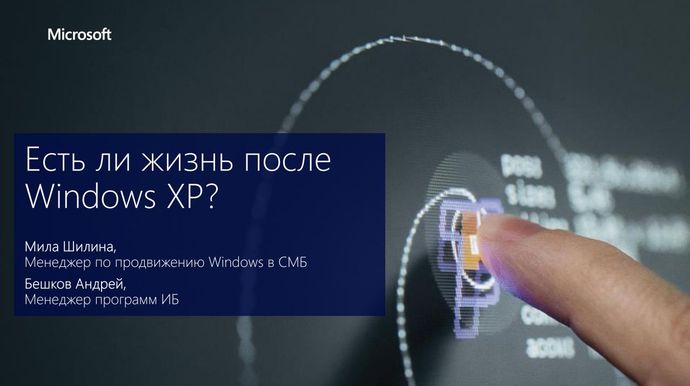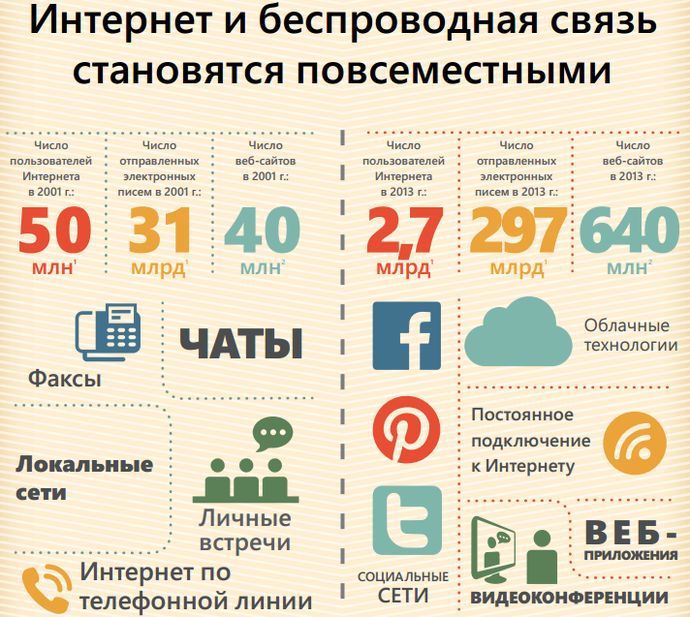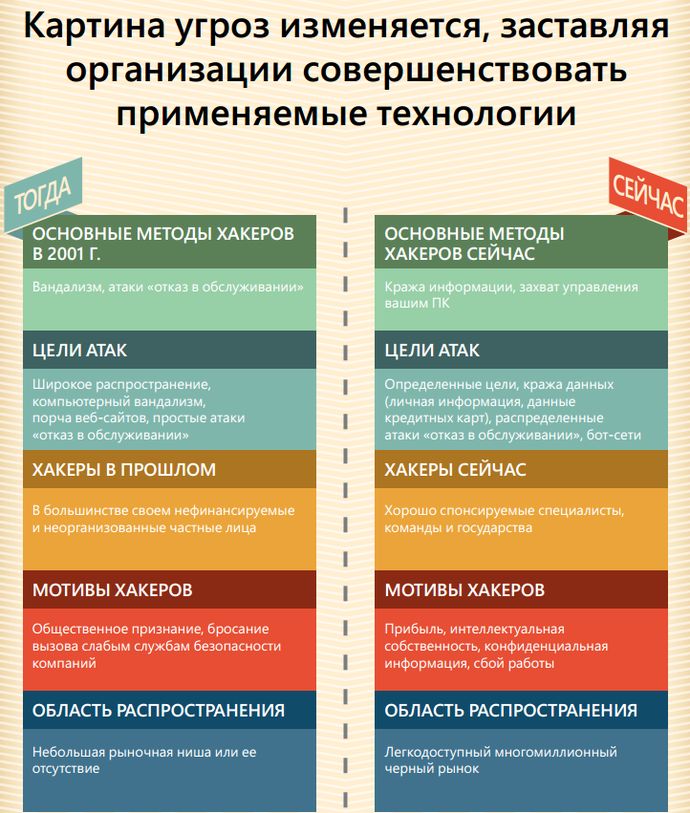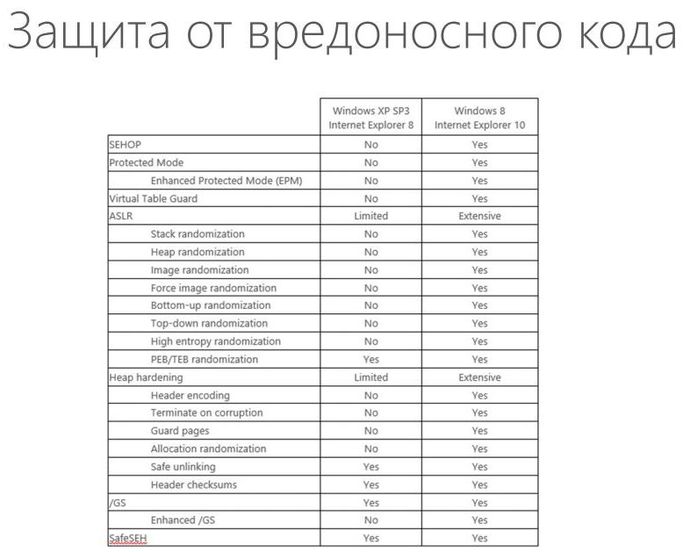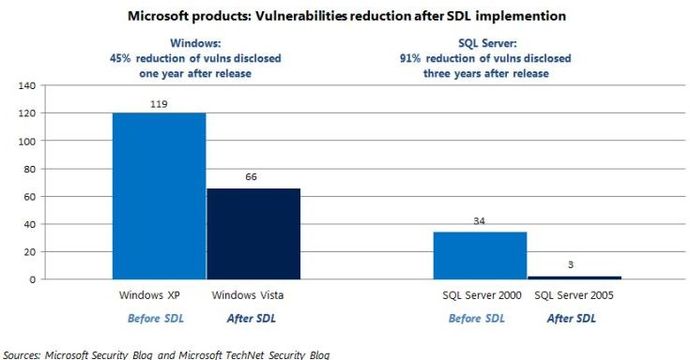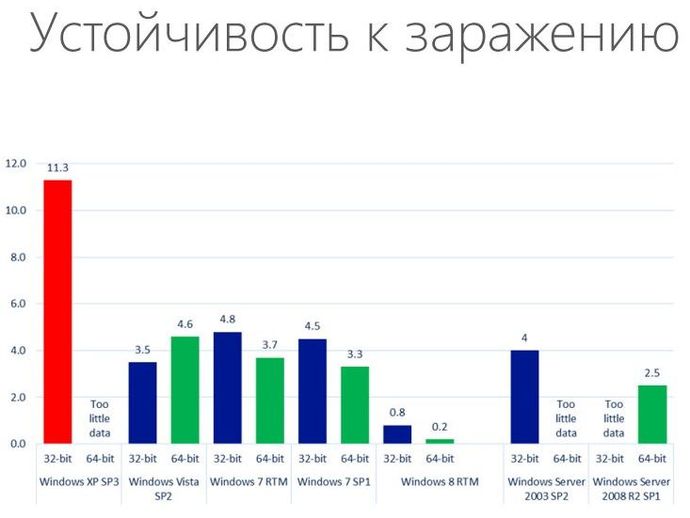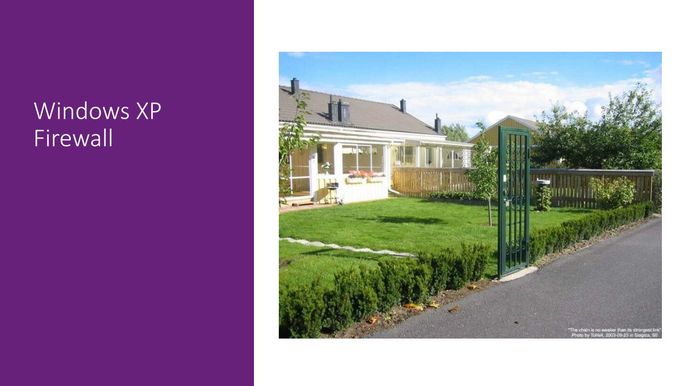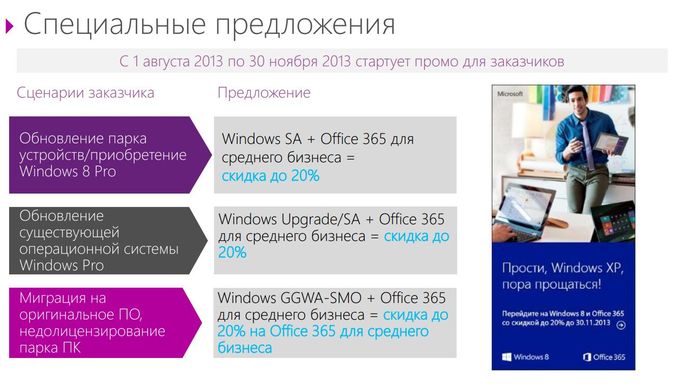Что означает окончание поддержки Windows XP?
Корпорация Майкрософт в течение 12 лет предоставляла поддержку для Windows XP. Теперь для нас и наших партнеров настало время инвестировать в более современные технологии, которые позволят нам и дальше разрабатывать и развивать новые эффективные способы работы. В результате техническая поддержка по Windows XP больше не доступна. Это относится и к автоматическим обновлениям, которые повышают защиту компьютера.
Также корпорация Майкрософт прекратила предоставлять Microsoft Security Essentials для загрузки в Windows XP. Если у вас уже установлены эти компоненты, в течение некоторого времени вы будете получать обновления антивредоносных сигнатур. Однако помните, что эффективность Microsoft Security Essentials (или любых других антивирусных программ) будет ограничена на компьютерах без последних обновлений для системы безопасности. Это значит, что компьютеры под управлением Windows XP будут незащищенными и находиться под угрозой заражения.
Что произойдет, если я продолжу использовать Windows XP?
Если вы продолжите использовать Windows XP после окончания поддержки, ваш компьютер по-прежнему будет работать, но может стать уязвимым для вирусов и других угроз безопасности. Кроме того, прекращена поддержка Internet Explorer 8, поэтому использование этого браузера на компьютере с Windows XP связано с дополнительным риском. Так как большинство производителей продолжает оптимизировать свое оборудование и программы для последних версий Windows, вы также можете обнаружить, что многие приложения и устройства не работают с Windows XP.
Моя версия Windows больше не поддерживается. Что это значит?
Как узнать свою версию Windows?
Как защитить себя?
У вас есть два способа обеспечить защиту компьютера после окончания поддержки:
Обновите текущую операционную систему
Далеко не все устаревшие компьютеры поддерживают Windows 10, новейшую версию операционной системы Windows. Мы рекомендуем вам просмотреть страницу характеристик Windows 10, чтобы узнать, соответствует ли ваш ПК системным требованиям для Windows 10. Более подробные сведения приведены на странице вопросов и ответов.
Купите новый компьютер
Если ваш компьютер не поддерживает Windows 10, возможно, стоит приобрести новый? Обязательно ознакомьтесь с нашей подборкой лучших современных компьютеров. Новые компьютеры — мощные, легкие и стильные. Кроме того, средняя цена таких устройств существенно ниже, чем 14 лет назад.
Найдите свой идеальный ПК
Нужна дополнительная помощь?
Нужны дополнительные параметры?
Изучите преимущества подписки, просмотрите учебные курсы, узнайте, как защитить свое устройство и т. д.
В сообществах можно задавать вопросы и отвечать на них, отправлять отзывы и консультироваться с экспертами разных профилей.
Корпорация Майкрософт в течение 12 лет предоставляла поддержку для Windows XP.
И с 8 апреля 2014 г. прекращается техническая поддержка Windows XP и выпуск автоматических обновлений, которые повышают защиту компьютера. Также с этого дня пользователь больше не сможет скачать программу Microsoft Security Essentials для Windows XP. Если продолжить использовать Windows XP после окончания поддержки то, компьютер может стать уязвимым для вирусов и других угроз безопасности.
Специально по такому случаю разработчики выпустили трогательное видео, рассказывающее о том, чего смогли добиться пользователи вместе с Windows XP. В конце ролика, Microsoft призывает перейти со старой версии операционной системы, на более новую Windows 8.1.
Кроме того, на сайте Microsoft открылся промо-раздел о завершении поддержки Windows XP — happywinday.com с забавным роликом на главной странице.
Спасибо Windows XP, но пора прощаться!
Операционная система Windows XP вышла 25 октября 2001 года и до сих пор является одной из самых распространенных ОС в мире — она находится на втором месте, уступая только Windows 7. Согласно данным NetMarketShare на март 2014 года, в мире все еще более четверти (27,69%) всех компьютеров работают на Windows XP.
Напоминаю, что подписаться, чтобы не пропустить новые обзоры и статьи можно 



Только зарегистрированные пользователи могут участвовать в опросе. Войдите, пожалуйста.
Какими операционными системами Вы пользуетесь на домашних компьютерах и ноутбуках?
36.61%
Windows 8/8.1
2561
0.37%
У меня нет ни домашнего компьютера, ни ноутбука
26
Проголосовали 6996 пользователей.
Воздержались 202 пользователя.
| Version of the Windows NT operating system | |

Screenshot of Windows XP running the Luna visual style, showing the start menu, taskbar, and My Computer window |
|
| Developer | Microsoft |
|---|---|
| Source model |
|
| Released to manufacturing |
August 24, 2001; 22 years ago[2] |
| General availability |
October 25, 2001; 21 years ago[2] |
| Final release | Service Pack 3 (5.1.2600.5512) / April 21, 2008; 15 years ago[3] |
| Marketing target | Consumer and Business |
| Update method |
|
| Platforms | IA-32, x86-64, and Itanium |
| Kernel type | Hybrid (NT) |
| Userland |
|
| License | Proprietary commercial software |
| Preceded by |
|
| Succeeded by | Windows Vista (2007) |
| Official website | Windows XP (archived at Wayback Machine) |
| Support status | |
| Excludes Itanium and some embedded editions: Mainstream support ended on April 14, 2009.[4] Extended support ended on April 8, 2014.[4] Exceptions exist until at most April 9, 2019, |
Windows XP is a major release of Microsoft’s Windows NT operating system. It was released to manufacturing on August 24, 2001, and later to retail on October 25, 2001. It is a direct upgrade to its predecessors, Windows 2000 for high-end and business users and Windows Me for home users, and is available for any devices running Windows NT 4.0, Windows 98, Windows 2000, or Windows Me that meet the new Windows XP system requirements.
Development of Windows XP began in the late 1990s under the codename «Neptune», built on the Windows NT kernel and explicitly intended for mainstream consumer use. An updated version of Windows 2000 was also initially planned for the business market. However, in January 2000, both projects were scrapped in favor of a single OS codenamed «Whistler», which would serve as a single platform for both consumer and business markets. As a result, Windows XP is the first consumer edition of Windows not based on the Windows 95 kernel or MS-DOS. Windows XP removed support for PC-98, i486 and SGI Visual Workstation 320 and 540 and will only run on 32-bit x86 CPUs and devices that use BIOS firmware.
Upon its release, Windows XP received critical acclaim, noting increased performance and stability (especially compared to Windows Me), a more intuitive user interface, improved hardware support, and expanded multimedia capabilities. Windows XP and Windows Server 2003 were succeeded by Windows Vista and Windows Server 2008, released in 2007 and 2008, respectively. However, some criticisms of Windows XP were its security issues at launch, and many people believed their anti-piracy schemes had gone too far.
Mainstream support for Windows XP ended on April 14, 2009, and extended support ended on April 8, 2014. Windows Embedded POSReady 2009, based on Windows XP Professional, received security updates until April 2019. After that, unofficial methods were made available to apply the updates to other editions of Windows XP. Microsoft discouraged this practice, citing compatibility issues.[5] However, over eight years from the end of life date (September 2022), the majority of PCs in some countries (such as Armenia) still appeared to be running on Windows XP.[6] As of September 2022, globally, just 0.39% of Windows PCs[7] and 0.1% of all devices across all platforms continued to run Windows XP.
Development
In the late 1990s, initial development of what would become Windows XP was focused on two individual products: «Odyssey», which was reportedly intended to succeed the future Windows 2000 and «Neptune», which was reportedly a consumer-oriented operating system using the Windows NT architecture, succeeding the MS-DOS-based Windows 98.[8]
However, the projects proved to be too ambitious. In January 2000, shortly prior to the official release of Windows 2000, technology writer Paul Thurrott reported that Microsoft had shelved both Neptune and Odyssey in favor of a new product codenamed «Whistler», named after Whistler, British Columbia, as many Microsoft employees skied at the Whistler-Blackcomb ski resort.[9] The goal of Whistler was to unify both the consumer and business-oriented Windows lines under a single, Windows NT platform. Thurrott stated that Neptune had become «a black hole when all the features that were cut from Windows Me were simply re-tagged as Neptune features. And since Neptune and Odyssey would be based on the same code-base anyway, it made sense to combine them into a single project».[10]
At PDC on July 13, 2000, Microsoft announced that Whistler would be released during the second half of 2001, and also unveiled the first preview build, 2250, which featured an early implementation of Windows XP’s visual styles system and interface changes to Windows Explorer and the Control Panel.[11]
Microsoft released the first public beta build of Whistler, build 2296, on October 31, 2000. Subsequent builds gradually introduced features that users of the release version of Windows XP would recognize, such as Internet Explorer 6.0, the Microsoft Product Activation system and the Bliss desktop background.[12]
Whistler was officially unveiled during a media event on February 5, 2001, under the name Windows XP, where XP stands for «eXPerience».[13]
Release
In June 2001, Microsoft indicated that it was planning to spend at least US$1 billion on marketing and promoting Windows XP, in conjunction with Intel and other PC makers.[14] The theme of the campaign, «Yes You Can», was designed to emphasize the platform’s overall capabilities. Microsoft had originally planned to use the slogan «Prepare to Fly», but it was replaced because of sensitivity issues in the wake of the September 11 attacks.[15]
On August 24, 2001, Windows XP build 2600 was released to manufacturing (RTM). During a ceremonial media event at Microsoft Redmond Campus, copies of the RTM build were given to representatives of several major PC manufacturers in briefcases, who then flew off on decorated helicopters. While PC manufacturers would be able to release devices running XP beginning on September 24, 2001, XP was expected to reach general, retail availability on October 25, 2001. On the same day, Microsoft also announced the final retail pricing of XP’s two main editions, «Home» (as a replacement for Windows Me for home computing) and «Professional» (as a replacement for Windows 2000 for high-end users).[16]
New and updated features
User interface
While retaining some similarities to previous versions, Windows XP’s interface was overhauled with a new visual appearance, with an increased use of alpha compositing effects, drop shadows, and «visual styles», which completely changed the appearance of the operating system. The number of effects enabled are determined by the operating system based on the computer’s processing power, and can be enabled or disabled on a case-by-case basis. XP also added ClearType, a new subpixel rendering system designed to improve the appearance of fonts on liquid-crystal displays.[17] A new set of system icons was also introduced.[18] The default wallpaper, Bliss, is a photo of a landscape in the Napa Valley outside Napa, California, with rolling green hills and a blue sky with stratocumulus and cirrus clouds.[19]
The Start menu received its first major overhaul in XP, switching to a two-column layout with the ability to list, pin, and display frequently used applications, recently opened documents, and the traditional cascading «All Programs» menu. The taskbar can now group windows opened by a single application into one taskbar button, with a popup menu listing the individual windows. The notification area also hides «inactive» icons by default. A «common tasks» list was added, and Windows Explorer’s sidebar was updated to use a new task-based design with lists of common actions; the tasks displayed are contextually relevant to the type of content in a folder (e.g. a folder with music displays offers to play all the files in the folder, or burn them to a CD).[20]
The «task grouping» feature introduced in Windows XP showing both grouped and individual items
Fast user switching allows additional users to log into a Windows XP machine without existing users having to close their programs and log out. Although only one user at the time can use the console (i.e., monitor, keyboard, and mouse), previous users can resume their session once they regain control of the console.[21] Service Pack 2 and Service Pack 3 also introduced new features to Windows XP post-release, including the Windows Security Center, Bluetooth support, the executable space protection, Windows Firewall, and support for SDHC cards that are larger than 4 GB and smaller than 32 GB.[22][23][24][25]
Infrastructure
Windows XP uses prefetching to improve startup and application launch times.[26] It also became possible to revert the installation of an updated device driver, should the updated driver produce undesirable results.[27]
A copy protection system known as Windows Product Activation was introduced with Windows XP and its server counterpart, Windows Server 2003. All Windows licenses must be tied to a unique ID generated using information from the computer hardware, transmitted either via the internet or a telephone hotline. If Windows is not activated within 30 days of installation, the OS will cease to function until it is activated. Windows also periodically verifies the hardware to check for changes. If significant hardware changes are detected, the activation is voided, and Windows must be re-activated.[28]
Networking and internet functionality
Windows XP was originally bundled with Internet Explorer 6, Outlook Express 6, Windows Messenger, and MSN Explorer. New networking features were also added, including Internet Connection Firewall, Internet Connection Sharing integration with UPnP, NAT traversal APIs, Quality of Service features, IPv6 and Teredo tunneling, Background Intelligent Transfer Service, extended fax features, network bridging, peer to peer networking, support for most DSL modems, IEEE 802.11 (Wi-Fi) connections with auto configuration and roaming, TAPI 3.1, and networking over FireWire.[29] Remote Assistance and Remote Desktop were also added, which allow users to connect to a computer running Windows XP from across a network or the Internet and access their applications, files, printers, and devices or request help.[30] Improvements were also made to IntelliMirror features such as Offline Files, Roaming user profiles and Folder redirection.[31]
Backwards compatibility
To enable running software that targets or locks out specific versions of Windows, «Compatibility mode» was added. The feature allows pretending a selected earlier version of Windows to software, starting at Windows 95.[32]
While this ability was first introduced in Windows 2000 Service Pack 2, it had to be activated through the «register server» and was only available to administrator users, whereas Windows XP has it activated out of the box and also grants it to regular users.[33]
Other features
- Improved application compatibility and shims compared to Windows 2000.[34]
- DirectX 8.1, upgradeable to DirectX 9.0c.[35]
- A number of new features in Windows Explorer including task panes, thumbnails, and the option to view photos as a slideshow.[36]
- Improved imaging features such as Windows Picture and Fax Viewer.[37]
- Faster start-up, (because of improved Prefetch functions) logon, logoff, hibernation, and application launch sequences.[26]
- Numerous improvements to increase the system reliability such as improved System Restore,[38] Automated System Recovery,[39] and driver reliability improvements through Device Driver Rollback.[40]
- Hardware support improvements such as FireWire 800,[41] and improvements to multi-monitor support under the name «DualView».[42]
- Fast user switching.[43]
- The ClearType font rendering mechanism, which is designed to improve text readability on liquid-crystal display (LCD) and similar monitors, especially laptops.[17]
- Side-by-side assemblies[44] and registration-free COM.[45]
- General improvements to international support such as more locales, languages and scripts, MUI support in Terminal Services, improved Input Method Editors, and National Language Support.[46]
Removed features
Some of the programs and features that were part of the previous versions of Windows did not make it to Windows XP. Various MS-DOS commands available in its Windows 9x predecessor were removed,[47] as were the POSIX and OS/2 subsystems.[48]
In networking, NetBEUI, NWLink and NetDDE were deprecated and not installed by default.[49] Plug-and-play–incompatible communication devices (like modems and network interface cards) were no longer supported.[50]
Service Pack 2 and Service Pack 3 also removed features from Windows XP, including support for TCP half-open connections[51] and the address bar on the taskbar.[52]
Editions
Windows XP was released in two major editions on launch: Home Edition and Professional Edition. Both editions were made available at retail as pre-loaded software on new computers and as boxed copies. Boxed copies were sold as «Upgrade» or «Full» licenses; the «Upgrade» versions were slightly cheaper, but require an existing version of Windows to install. The «Full» version can be installed on systems without an operating system or existing version of Windows.[14] The two editions of XP were aimed at different markets: Home Edition is explicitly intended for consumer use and disables or removes certain advanced and enterprise-oriented features present on Professional, such as the ability to join a Windows domain, Internet Information Services, and Multilingual User Interface. Windows 98 or Me can be upgraded to either edition, but Windows NT 4.0 and Windows 2000 can only be upgraded to Professional.[53] Windows’ software license agreement for pre-loaded licenses allows the software to be «returned» to the OEM for a refund if the user does not wish to use it.[54] Despite the refusal of some manufacturers to honor the entitlement, it has been enforced by courts in some countries.[55]
Two specialized variants of XP were introduced in 2002 for certain types of hardware, exclusively through OEM channels as pre-loaded software. Windows XP Media Center Edition was initially designed for high-end home theater PCs with TV tuners (marketed under the term «Media Center PC»), offering expanded multimedia functionality, an electronic program guide, and digital video recorder (DVR) support through the Windows Media Center application.[56] Microsoft also unveiled Windows XP Tablet PC Edition, which contains additional pen input features, and is optimized for mobile devices meeting its Tablet PC specifications.[57] Two different 64-bit editions of XP were made available. The first, Windows XP 64-Bit Edition, was intended for IA-64 (Itanium) systems; as IA-64 usage declined on workstations in favor of AMD’s x86-64 architecture, the Itanium edition was discontinued in January 2005.[58] A new 64-bit edition supporting the x86-64 architecture, called Windows XP Professional x64 Edition, was released in April of the same year.[59]
Microsoft also targeted emerging markets with the 2004 introduction of Windows XP Starter Edition, a special variant of Home Edition intended for low-cost PCs. The OS is primarily aimed at first-time computer owners, containing heavy localization (including wallpapers and screen savers incorporating images of local landmarks), and a «My Support» area which contains video tutorials on basic computing tasks. It also removes certain «complex» features, and does not allow users to run more than three applications at a time. After a pilot program in India and Thailand, Starter was released in other emerging markets throughout 2005.[60] In 2006, Microsoft also unveiled the FlexGo initiative, which would also target emerging markets with subsidized PCs on a pre-paid, subscription basis.[61]
As a result of unfair competition lawsuits in Europe and South Korea, which both alleged that Microsoft had improperly leveraged its status in the PC market to favor its own bundled software, Microsoft was ordered to release special editions of XP in these markets that excluded certain applications. In March 2004, after the European Commission fined Microsoft €497 million (US$603 million), Microsoft was ordered to release «N» editions of XP that excluded Windows Media Player, encouraging users to pick and download their own media player software.[62] As it was sold at the same price as the edition with Windows Media Player included, certain OEMs (such as Dell, who offered it for a short period, along with Hewlett-Packard, Lenovo and Fujitsu Siemens) chose not to offer it. Consumer interest was minuscule, with roughly 1,500 units shipped to OEMs, and no reported sales to consumers.[63] In December 2005, the Korean Fair Trade Commission ordered Microsoft to make available editions of Windows XP and Windows Server 2003 that do not contain Windows Media Player or Windows Messenger.[64] The «K» and «KN» editions of Windows XP were released in August 2006, and are only available in English and Korean, and also contain links to third-party instant messenger and media player software.[65]
Service packs
A service pack is a cumulative update package that is a superset of all updates, and even service packs, that have been released before it.[66] Three service packs have been released for Windows XP. Service Pack 3 is slightly different, in that it needs at least Service Pack 1 to have been installed, in order to update a live OS.[67] However, Service Pack 3 can still be embedded into a Windows installation disc; SP1 is not reported as a prerequisite for doing so.[68]
The unique boot screens from the RTM to Service Pack 1 versions of Windows XP that identified the edition of Windows XP currently running, including a green progress bar for Home Edition and a blue progress bar for Professional, Embedded, Tablet PC Edition, and Media Center Edition were removed in Service Pack 2 of Windows XP and was replaced with a generic «Windows XP» boot screen with a blue progress bar.
Service Pack 1
Service Pack 1 (SP1) for Windows XP was released on September 9, 2002. It contained over 300 minor, post-RTM bug fixes, along with all security patches released since the original release of XP. SP1 also added USB 2.0 support, the Microsoft Java Virtual Machine, .NET Framework support, and support for technologies used by the then-upcoming Media Center and Tablet PC editions of XP.[69] The most significant change on SP1 was the addition of Set Program Access and Defaults, a settings page which allows programs to be set as default for certain types of activities (such as media players or web browsers) and for access to bundled, Microsoft programs (such as Internet Explorer or Windows Media Player) to be disabled. This feature was added to comply with the settlement of United States v. Microsoft Corp., which required Microsoft to offer the ability for OEMs to bundle third-party competitors to software it bundles with Windows (such as Internet Explorer and Windows Media Player), and give them the same level of prominence as those normally bundled with the OS.[70]
On February 3, 2003, Microsoft released Service Pack 1a (SP1a). It was the same as SP1, except the Microsoft Java Virtual Machine was excluded.[71]
Service Pack 2
Service Pack 2 (SP2) for Windows XP Home edition and Professional edition was released on August 25, 2004.[72] Headline features included WPA encryption compatibility for Wi-Fi and usability improvements to the Wi-Fi networking user interface,[73] partial Bluetooth support,[74] and various improvements to security systems.
Headed by former computer hacker Window Snyder,[75][76] the service pack’s security improvements (codenamed «Springboard»,[77] as these features were intended to underpin additional changes in Longhorn) included a major revision to the included firewall (renamed Windows Firewall, and now enabled by default), and an update to Data Execution Prevention, which gained hardware support in the NX bit that can stop some forms of buffer overflow attacks. Raw socket support is removed (which supposedly limits the damage done by zombie machines) and the Windows Messenger service (which had been abused to cause pop-up advertisements to be displayed as system messages without a web browser or any additional software) became disabled by default. Additionally, security-related improvements were made to e-mail and web browsing. Service Pack 2 also added Security Center, an interface that provides a general overview of the system’s security status, including the state of the firewall and automatic updates. Third-party firewall and antivirus software can also be monitored from Security Center.[78]
In August 2006, Microsoft released updated installation media for Windows XP and Windows Server 2003 SP2 (SP2b), in order to incorporate a patch requiring ActiveX controls in Internet Explorer to be manually activated before a user may interact with them. This was done so that the browser would not violate a patent owned by Eolas.[79] Microsoft has since licensed the patent, and released a patch reverting the change in April 2008.[80] In September 2007, another minor revision known as SP2c was released for XP Professional, extending the number of available product keys for the operating system to «support the continued availability of Windows XP Professional through the scheduled system builder channel end-of-life (EOL) date of January 31, 2009.»[81]
Windows XP Service Pack 2 was later included in Windows Embedded for Point of Service and Windows Fundamentals for Legacy PCs.
Service Pack 3
The third and final Service Pack, SP3, was released through different channels between April[3] and June 2008,[82] about a year after the release of Windows Vista, and about a year before the release of Windows 7. Service Pack 3 was not available for Windows XP x64 Edition, which was based on the Windows Server 2003 kernel and, as a result, used its service packs[83] rather than the ones for the other editions.[84]
It began being automatically pushed out to Automatic Updates users on July 10, 2008.[85] A feature set overview which detailed new features available separately as stand-alone updates to Windows XP, as well as backported features from Windows Vista, was posted by Microsoft.[86] A total of 1,174 fixes are included in SP3.[87] Service Pack 3 could be installed on systems with Internet Explorer up to and including version 8; Internet Explorer 7 was not included as part of SP3.[88] It also did not include Internet Explorer 8, but instead was included in Windows 7, which was released one year after XP SP3.
Service Pack 3 included security enhancements over and above those of SP2, including APIs allowing developers to enable Data Execution Prevention for their code, independent of system-wide compatibility enforcement settings,[89] the Security Support Provider Interface,[90] improvements to WPA2 security,[91] and an updated version of the Microsoft Enhanced Cryptographic Provider Module that is FIPS 140-2 certified.[92]
In incorporating all previously released updates not included in SP2, Service Pack 3 included many other key features. Windows Imaging Component allowed camera vendors to integrate their own proprietary image codecs with the operating system’s features, such as thumbnails and slideshows.[93] In enterprise features, Remote Desktop Protocol 6.1 included support for ClearType and 32-bit color depth over RDP,[94] while improvements made to Windows Management Instrumentation in Windows Vista to reduce the possibility of corruption of the WMI repository were backported to XP SP3.[95]
In addition, SP3 contains updates to the operating system components of Windows XP Media Center Edition (MCE) and Windows XP Tablet PC Edition, and security updates for .NET Framework version 1.0, which is included in these editions. However, it does not include update rollups for the Windows Media Center application in Windows XP MCE 2005.[96] SP3 also omits security updates for Windows Media Player 10, although the player is included in Windows XP MCE 2005.[96] The Address Bar DeskBand on the Taskbar is no longer included because of antitrust violation concerns.[97]
Unofficial SP3 ZIP download packages were released on a now-defunct website called The Hotfix from 2005 to 2007.[98][99] The owner of the website, Ethan C. Allen, was a former Microsoft employee in Software Quality Assurance and would comb through the Microsoft Knowledge Base articles daily and download new hotfixes Microsoft would put online within the articles. The articles would have a «kbwinxppresp3fix» and/or «kbwinxpsp3fix» tag, thus allowing Allen to easily find and determine which fixes were planned for the official SP3 release to come. Microsoft publicly stated at the time that the SP3 pack was unofficial and advised users to not install it.[100][101] Allen also released a Vista SP1 package in 2007, for which Allen received a cease-and-desist email from Microsoft.[102]
Windows XP Service Pack 3 was later included in Windows Embedded Standard 2009 and Windows Embedded POSReady 2009.
System requirements
System requirements for Windows XP are as follows:
| Minimum | Recommended | |
|---|---|---|
| Home/Professional Edition[A] | ||
| CPU |
|
|
| Memory | 64 MB[E][F] | 128 MB |
| Free space |
|
|
| Media | CD-ROM drive or compatible | |
| Display | Super VGA (800 × 600) or over | 1024 x 768 or over |
| Sound hardware | N/A | Sound card plus speakers/headphones |
| Input device(s) | Keyboard, mouse | |
| Professional x64 Edition[J] | ||
| CPU |
|
|
| Memory | 256 MB | |
| Free space |
|
|
| Media | CD-ROM drive or compatible | |
| Display | Super VGA (800 × 600) or over | 1024 x 768 or over |
| Sound hardware | N/A | Sound card plus speakers/headphones |
| Input device(s) | Keyboard, mouse | |
| 64-Bit Edition[K] | ||
| CPU | Itanium 733 MHz | Itanium 800 MHz |
| Memory | 1 GB | |
| Free space | 6 GB | |
| Media | CD-ROM drive or compatible | |
| Display | Super VGA (800 × 600) or over | 1024 x 768 or over |
| Input device(s) | Keyboard, mouse |
Notes
- ^ «System requirements for Windows XP operating systems». April 28, 2005. Archived from the original on August 6, 2011. Retrieved March 12, 2007.
- ^ Even though this is Microsoft’s stated minimum processor speed for Windows XP, it is possible to install and run the operating system on early IA-32 processors such as a P5 Pentium without MMX instructions. Windows XP is not compatible with processors older than Pentium (such as 486) or the Cyrix 6×86 because it requires the
CMPXCHG8Binstruction. - ^ «Windows XP Minimal Requirement Test». Winhistory.de. September 9, 2011. Archived from the original on December 21, 2011. Retrieved January 1, 2012.
- ^ a b c d e «Windows XP: Required firmware and partition mapping scheme of hard disk drive». Support.microsoft.com. June 26, 2013. Archived from the original on April 27, 2017. Retrieved June 16, 2014.
- ^ A Microsoft TechNet paper from Summer 2001 (before Windows XP’s actual release), states that: «A computer with 64 MB of RAM will have sufficient resources to run Windows XP and a few applications with moderate memory requirements.» (Emphasis added.) These were said to be office productivity applications, e-mail programs, and web browsers (of the time). With such a configuration, user interface enhancements and fast user switching are turned off by default. For comparable workloads, 64 MB of RAM was then regarded as providing an equal or better user experience on Windows XP with similar settings than it would with Windows Me on the same hardware. In a later section of the paper, superior performance over Windows Me was noted with 128 MB of RAM or more, and with computers that exceed the minimum hardware requirements.
- ^ Sechrest, Stuart; Fortin, Michael (June 1, 2001). «Windows XP Performance». Microsoft TechNet. Archived from the original on July 27, 2010. Retrieved April 8, 2008.
- ^ «Hard disk space requirements for Windows XP Service Pack 1». Microsoft. October 29, 2007. Archived from the original on April 21, 2012. Retrieved April 6, 2012.
- ^ «The hard disk space requirements for Windows XP Service Pack 2». Microsoft. April 18, 2005. Archived from the original on November 24, 2010. Retrieved December 1, 2010.
- ^ «Windows XP – End of Support, Migration Guide, Download – TechNet». technet.microsoft.com. 2007. Archived from the original on May 13, 2008.
- ^ «Windows XP Professional x64 Edition SP2 VL EN (MSDN-TechNet)». Programmer Stuffs. March 23, 2011. Archived from the original on July 14, 2014. Retrieved May 2, 2012.
- ^ «Microsoft Windows XP 64-Bit Edition». Microsoft TechNet. Microsoft. August 15, 2001. Archived from the original on April 19, 2012. Retrieved May 2, 2012.
Physical memory limits
The maximum amount of RAM that Windows XP can support varies depending on the product edition and the processor architecture. All 32-bit editions of XP support up to 4 GB, except the Windows XP Starter edition, which supports up to 512 MB of RAM.[103] 64-bit editions support up to 128 GB.[104]
Processor limits
Windows XP Professional supports up to two physical processors;[105]
Windows XP Home Edition supports only one.[106]
However, XP supports a greater number of logical processors:
32-bit editions support up to 32 logical processors,[107] and 64-bit editions support up to 64 logical processors.[108]
Upgradeability
Several Windows XP components are upgradable to the latest versions, which include new versions introduced in later versions of Windows, and other major Microsoft applications are available. These latest versions for Windows XP include:
- ActiveSync 4.5
- DirectX 9.0c (June 7, 2010, Redistributable)
- Internet Explorer 8 on Windows XP Service Packs 2 and 3 (Internet Explorer 6 SP1 and Outlook Express 6 SP1 on Windows XP before SP2.)
- Windows Media Format Runtime and Windows Media Player 11 on Windows XP Service Packs 2 and 3 (and Windows Media Player 10 on Windows XP original release.)
- Microsoft Virtual PC 2004 and 2007
- .NET Framework up to and including version 4.0 (4.5 and higher versions are not supported.)
- Visual Studio 2005 on Windows XP versions below SP2, Visual Studio 2008 on Windows XP SP2 and Visual Studio 2010 on Windows XP SP3
- Windows Script Host 5.7
- Windows Installer 4.5
- Microsoft NetMeeting 3.02
- Office 2010 was the last version of Microsoft Office to be compatible with Windows XP.
- The Windows Services for UNIX subsystem can be installed to allow certain Unix-based applications to run on the operating system.
Support lifecycle
| Expiration date | |
|---|---|
| Mainstream support | April 14, 2009[4] |
| Extended support | April 8, 2014[4] The official exceptions ended in April 2019. |
| Applicable XP editions: | |
| Home Edition, Professional Edition, Professional x64 Edition, Professional for Embedded Systems, Media Center Editions (all), Starter Edition, Tablet PC Edition and Tablet PC Edition 2005,[4] as well as Windows Fundamentals for Legacy PCs.[109] | |
| Exceptions | |
| Windows XP 64-Bit Edition (Itanium edition, including Version 2003) | Unsupported as of June 30, 2005[110] |
| Windows XP Embedded | Mainstream support ended on January 11, 2011[4] Extended support ended on January 12, 2016[4] |
| Windows Embedded for Point of Service | Mainstream support ended on April 12, 2011[111] Extended support ended on April 12, 2016[111] |
| Windows Embedded Standard 2009 | Mainstream support ended on January 14, 2014 Extended support ended on January 8, 2019[112] |
| Windows Embedded POSReady 2009 | Mainstream support ended on April 8, 2014 Extended support ended on April 9, 2019[113] |
Support for the original release of Windows XP (without a service pack) ended on August 30, 2005.[4] Both Windows XP Service Pack 1 and 1a were retired on October 10, 2006,[4] and both Windows 2000 and Windows XP SP2 reached their end of support on July 13, 2010, about 24 months after the launch of Windows XP Service Pack 3.[4] The company stopped general licensing of Windows XP to OEMs and terminated retail sales of the operating system on June 30, 2008, 17 months after the release of Windows Vista.[114] However, an exception was announced on April 3, 2008, for OEMs producing what it defined as «ultra low-cost personal computers», particularly netbooks, until one year after the availability of Windows 7 on October 22, 2009. Analysts felt that the move was primarily intended to compete against Linux-based netbooks, although Microsoft’s Kevin Hutz stated that the decision was due to apparent market demand for low-end computers with Windows.[115]
Variants of Windows XP for embedded systems have different support policies: Windows XP Embedded SP3 and Windows Embedded for Point of Service SP3 were supported until January and April 2016, respectively. Windows Embedded Standard 2009, which was succeeded by Windows Embedded Standard 7, and Windows Embedded POSReady 2009, which was succeeded by Windows Embedded POSReady 7, were supported until January and April 2019, respectively.[116] These updates, while intended for the embedded editions, could also be downloaded on standard Windows XP with a registry hack, which enabled unofficial patches until April 2019. However, Microsoft advised Windows XP users against installing these fixes, citing incompatibility issues.[5][117]
End of support
On April 14, 2009, Windows XP exited mainstream support and entered the extended support phase; Microsoft continued to provide security updates every month for Windows XP, however, free technical support, warranty claims, and design changes were no longer being offered. Extended support ended on April 8, 2014, over 12 years after the release of Windows XP; normally Microsoft products have a support life cycle of only 10 years.[118] Beyond the final security updates released on April 8, no more security patches or support information are provided for XP free-of-charge; «critical patches» will still be created, and made available only to customers subscribing to a paid «Custom Support» plan.[119] As it is a Windows component, all versions of Internet Explorer for Windows XP also became unsupported.[120]
In January 2014, it was estimated that more than 95% of the 3 million automated teller machines in the world were still running Windows XP (which largely replaced IBM’s OS/2 as the predominant operating system on ATMs); ATMs have an average lifecycle of between seven and ten years, but some have had lifecycles as long as 15. Plans were being made by several ATM vendors and their customers to migrate to Windows 7-based systems over the course of 2014, while vendors have also considered the possibility of using Linux-based platforms in the future to give them more flexibility for support lifecycles, and the ATM Industry Association (ATMIA) has since endorsed Windows 10 as a further replacement.[121] However, ATMs typically run the embedded variant of Windows XP, which was supported through January 2016.[122] As of May 2017, around 60% of the 220,000 ATMs in India still run Windows XP.[123]
Furthermore, at least 49% of all computers in China still ran XP at the beginning of 2014. These holdouts were influenced by several factors; prices of genuine copies of later versions of Windows in the country are high, while Ni Guangnan of the Chinese Academy of Sciences warned that Windows 8 could allegedly expose users to surveillance by the United States government,[124] and the Chinese government banned the purchase of Windows 8 products for government use in May 2014 in protest of Microsoft’s inability to provide «guaranteed» support.[125] The government also had concerns that the impending end of support could affect their anti-piracy initiatives with Microsoft, as users would simply pirate newer versions rather than purchasing them legally. As such, government officials formally requested that Microsoft extend the support period for XP for these reasons. While Microsoft did not comply with their requests, a number of major Chinese software developers, such as Lenovo, Kingsoft and Tencent, will provide free support and resources for Chinese users migrating from XP.[126] Several governments, in particular those of the Netherlands and the United Kingdom, elected to negotiate «Custom Support» plans with Microsoft for their continued, internal use of Windows XP; the British government’s deal lasted for a year, and also covered support for Office 2003 (which reached end-of-life the same day) and cost £5.5 million.[127]
On March 8, 2014, Microsoft deployed an update for XP that, on the 8th of each month, displays a pop-up notification to remind users about the end of support; however, these notifications may be disabled by the user.[128] Microsoft also partnered with Laplink to provide a special «express» version of its PCmover software to help users migrate files and settings from XP to a computer with a newer version of Windows.[129]
Despite the approaching end of support, there were still notable holdouts that had not migrated past XP; many users elected to remain on XP because of the poor reception of Windows Vista, sales of newer PCs with newer versions of Windows declined because of the Great Recession and the effects of Vista, and deployments of new versions of Windows in enterprise environments require a large amount of planning, which includes testing applications for compatibility (especially those that are dependent on Internet Explorer 6, which is not compatible with newer versions of Windows).[130] Major security software vendors (including Microsoft itself) planned to continue offering support and definitions for Windows XP past the end of support to varying extents, along with the developers of Google Chrome, Mozilla Firefox, and Opera web browsers;[120] despite these measures, critics similarly argued that users should eventually migrate from XP to a supported platform.[131] The United States’ Computer Emergency Readiness Team released an alert in March 2014 advising users of the impending end of support, and informing them that using XP after April 8 may prevent them from meeting US government information security requirements.[132]
Microsoft continued to provide Security Essentials virus definitions and updates for its Malicious Software Removal Tool (MSRT) for XP until July 14, 2015.[133] As the end of extended support approached, Microsoft began to increasingly urge XP customers to migrate to newer versions such as Windows 7 or 8 in the interest of security, suggesting that attackers could reverse engineer security patches for newer versions of Windows and use them to target equivalent vulnerabilities in XP.[134] Windows XP is remotely exploitable by numerous security holes that were discovered after Microsoft stopped supporting it.[135][136]
Similarly, specialized devices that run XP, particularly medical devices, must have any revisions to their software—even security updates for the underlying operating system—approved by relevant regulators before they can be released. For this reason, manufacturers often did not allow any updates to devices’ operating systems, leaving them open to security exploits and malware.[137]
Despite the end of support for Windows XP, Microsoft has released three emergency security updates for the operating system to patch major security vulnerabilities:
- A patch released in May 2014 to address recently discovered vulnerabilities in Internet Explorer 6 through 11 on all versions of Windows.[138]
- A patch released in May 2017 to address a vulnerability that was being leveraged by the WannaCry ransomware attack.[139]
- A patch released in May 2019 to address a critical code execution vulnerability in Remote Desktop Services which can be exploited in a similar way as the WannaCry vulnerability.[140][141]
Researchers reported in August 2019 that Windows 10 users may be at risk for «critical» system compromise because of design flaws of hardware device drivers from multiple providers.[142] In the same month, computer experts reported that the BlueKeep security vulnerability, CVE-2019-0708, that potentially affects older unpatched Microsoft Windows versions via the program’s Remote Desktop Protocol, allowing for the possibility of remote code execution, may now include related flaws, collectively named DejaBlue, affecting newer Windows versions (i.e., Windows 7 and all recent versions) as well.[143] In addition, experts reported a Microsoft security vulnerability, CVE-2019-1162, based on legacy code involving Microsoft CTF and ctfmon (ctfmon.exe), that affects all Windows versions from the older Windows XP version to the most recent Windows 10 versions; a patch to correct the flaw is currently available.[144]
Microsoft announced in July 2019 that the Microsoft Internet Games services on Windows XP and Windows Me would end on July 31, 2019 (and for Windows 7 on January 22, 2020).[145] Others, such as Steam, had done the same, ending support for Windows XP and Windows Vista in January 2019.[146]
In 2020, Microsoft announced that it would disable the Windows Update service for SHA-1 endpoints; since Windows XP did not get an update for SHA-2, Windows Update Services are no longer available on the OS as of late July 2020.[147] However, as of October 2021, the old updates for Windows XP are still available on the Microsoft Update Catalog,[148] or through Legacy Update, a community-driven third party replacement for the Windows XP update servers.
Reception
On release, Windows XP received critical acclaim. CNET described the operating system as being «worth the hype», considering the new interface to be «spiffier» and more intuitive than previous versions, but feeling that it may «annoy» experienced users with its «hand-holding». XP’s expanded multimedia support and CD burning functionality were also noted, along with its streamlined networking tools. The performance improvements of XP in comparison to 2000 and Me were also praised, along with its increased number of built-in device drivers in comparison to 2000. The software compatibility tools were also praised, although it was noted that some programs, particularly older MS-DOS software, may not work correctly on XP because of its differing architecture. They panned Windows XP’s new licensing model and product activation system, considering it to be a «slightly annoying roadblock», but acknowledged Microsoft’s intent for the changes.[149] PC Magazine provided similar praise, although noting that a number of its online features were designed to promote Microsoft-owned services, and that aside from quicker boot times, XP’s overall performance showed little difference over Windows 2000.[150] Windows XP’s default theme, Luna, was criticized by some users for its childish look.[151][152]
Despite extended support for Windows XP ending in 2014, many users – including some enterprises – were reluctant to move away from an operating system they viewed as a stable known quantity despite the many security and functionality improvements in subsequent releases of Windows. Windows XP’s longevity was viewed as testament to its stability and Microsoft’s successful attempts to keep it up to date, but also as an indictment of its direct successor’s perceived failings.[153]
According to web analytics data generated by Net Applications, Windows XP was the most widely used operating system until August 2012, when Windows 7 overtook it (later overtaken by Windows 10),[154] while StatCounter indicates it happening almost a year earlier.[155] In January 2014, Net Applications reported a market share of 29.23%[156] of «desktop operating systems» for XP (when XP was introduced there was not a separate mobile category to track), while W3Schools reported a share of 11.0%.[157]
As of September 2022, in most regions or continents, Windows XP market share on PCs, as a fraction of the total Windows share, has gone below 1% (0.5% in Africa[158]). XP still has a double-digit market share in a few countries, such as Armenia at over 50%,[159][160][161][162] at 57%, where Windows 7 was highest ranked, and with it being replaced by Windows 10, Windows XP got highest ranked for the longest time, and had over 60% share on some weekends in the summer of 2019.[163][164]
Source code leak
On September 23, 2020, source code for Windows XP with Service Pack 1 and Windows Server 2003 was leaked onto the imageboard 4chan by an unknown user. Anonymous users managed to compile the code, as well as a Twitter user who posted videos of the process on YouTube proving that the code was genuine.[165] The videos were later removed on copyright grounds by Microsoft. The leak was incomplete as it was missing Winlogon and some other components.[166][167] The original leak itself was spread using magnet links and torrent files whose payload originally included Server 2003 and XP source code and which was later updated with additional files, among which were previous leaks of Microsoft products, its patents, media about conspiracy theories on Bill Gates by anti-vaccination movements and an assortment of PDF files on different topics.[168]
Microsoft issued a statement stating that it was investigating the leaks.[167][169][170]
See also
- BlueKeep (security vulnerability)
- Comparison of operating systems
- History of operating systems
- List of operating systems
References
- ^ «Windows Licensing Programs». Microsoft. Archived from the original on December 16, 2008. Retrieved September 21, 2008.
- ^ a b «An Inside Look at the Months-long Process of Getting Windows XP Ready for Release to Manufacturing | Stories». Microsoft Stories. Microsoft. August 24, 2001. Archived from the original on August 5, 2019. Retrieved June 24, 2018.
- ^ a b Kelly, Gordon (April 16, 2008). «Windows XP SP3 Release Date(s) Confirmed». Trusted Reviews. Trusted Reviews. Archived from the original on June 23, 2018. Retrieved June 23, 2018.
- ^ a b c d e f g h i j «Microsoft Product Lifecycle Search: Windows XP». Microsoft Support. Microsoft. Archived from the original on July 20, 2012. Retrieved May 14, 2022.
- ^ a b Seltzer, Larry (May 26, 2014). «Registry hack enables continued updates for Windows XP». ZDNet. Archived from the original on January 26, 2021. Retrieved January 30, 2021.
[UPDATE:] Late Monday we received a statement from a Microsoft spokesperson: We recently became aware of a hack that purportedly aims to provide security updates to Windows XP customers. The security updates that could be installed are intended for Windows Embedded and Windows Server 2003 customers and do not fully protect Windows XP customers. Windows XP customers also run a significant risk of functionality issues with their machines if they install these updates, as they are not tested against Windows XP. The best way for Windows XP customers to protect their systems is to upgrade to a more modern operating system, like Windows 7 or Windows 8.1.
- ^ «Desktop Windows Version Market Share in Armenia – September 2022». September 30, 2022. Retrieved October 10, 2022.
- ^ «Desktop Windows Version Market Share Worldwide | StatCounter Global Stats». gs.statcounter.com. Statcounter. Archived from the original on April 20, 2019. Retrieved May 8, 2022.
- ^ Miles, Stephanie (January 24, 2000). «Microsoft consolidates Windows development efforts». CNET. CNET Networks. Archived from the original on February 1, 2014. Retrieved January 23, 2014.
- ^ «Windows «Longhorn» FAQ». Paul Thurrott’s SuperSite for Windows. Penton Media. June 22, 2005. Archived from the original on April 4, 2008. Retrieved April 4, 2008.
- ^ Thurrott, Paul (October 6, 2010). «The Road to Gold: The development of Windows XP Reviewed». Paul Thurrott’s Supersite for Windows. Penton Media. Archived from the original on February 2, 2014. Retrieved January 23, 2014.
- ^ Thurrott, Paul (July 17, 2000). «Introducing the Whistler Preview, Build 2250». Windows IT Pro. Penton Media. Archived from the original on June 12, 2018. Retrieved June 9, 2018.
- ^ Thurrott, Paul (October 6, 2010). «The Road to Gold (Part Two)». Paul Thurrott’s SuperSite for Windows. Penton Media. Archived from the original on February 2, 2014. Retrieved January 23, 2014.
- ^ «Microsoft to christen Windows, Office with new name». CNET. CNET Networks. February 5, 2001. Archived from the original on February 1, 2014. Retrieved January 23, 2014.
- ^ a b «Windows XP marketing tab to hit $1 billion». CNET. CNET Networks. January 2, 2002. Archived from the original on February 1, 2014. Retrieved January 23, 2014.
- ^ «Microsoft changes XP slogan in wake of US attacks». Computerworld NZ. IDG. Archived from the original on September 5, 2015. Retrieved August 7, 2015.
- ^ Thurrott, Paul (October 15, 2001). «The Road to Gold (Part Three)». Paul Thurrott’s Supersite for Windows. Penton Media. Archived from the original on August 29, 2017. Retrieved March 11, 2017.
- ^ a b «HOW TO: Use ClearType to Enhance Screen Fonts in Windows XP». Support. Microsoft. October 27, 2002. Archived from the original on August 5, 2011. Retrieved August 8, 2011.
- ^ Esposito, Dino (November 2001). «New Graphical Interface: Enhance Your Programs with New Windows XP Shell Features». MSDN. Microsoft. Archived from the original on August 9, 2011. Retrieved August 8, 2011.
- ^ Turner, Paul (February 22, 2004). «No view of Palouse from Windows». The Spokesman-Review. Spokane. Archived from the original on May 11, 2011. Retrieved September 19, 2012.
- ^ Fitzpatrick, Jason (August 6, 2015). «The Start Menu Should Be Sacred (But It’s Still a Disaster in Windows 10)». How-To Geek. Archived from the original on March 13, 2017. Retrieved July 30, 2016.
- ^ «How To Use the Fast User Switching Feature in Windows XP (Revision 1.5)». Microsoft Support. Microsoft. March 27, 2007. Archived from the original on August 12, 2011. Retrieved August 8, 2011.
- ^ «Bluetooth Wireless Technology FAQ». Archived from the original on December 23, 2018. Retrieved August 8, 2011.
- ^ «Manually Configuring Windows Firewall in Windows XP Service Pack 2». May 5, 2010. Archived from the original on August 26, 2017. Retrieved August 26, 2017.
- ^ «Description of the Windows Firewall feature in Windows XP SP2». Archived from the original on September 17, 2009. Retrieved September 18, 2009.
- ^ «Hotfix for Windows XP that adds support for SDHC cards that have a capacity of more than 4 GB». Support (5.0 ed.). May 22, 2013. Archived from the original on February 5, 2014. Retrieved June 18, 2019.
- ^ a b «Kernel Enhancements for Windows XP». Windows Hardware Developer Center (WHDC). Microsoft. January 13, 2003. Archived from the original on March 7, 2008. Retrieved August 8, 2011.
- ^ «HOW TO: Use the Driver Roll Back Feature to Restore a Previous Version of a Device Driver in Windows XP». Microsoft. October 27, 2002. Archived from the original on February 18, 2006.
- ^ Fisher, Ken (February 2, 2001). «Windows Product Activation: an early look». Ars Technica. Archived from the original on December 5, 2011. Retrieved February 22, 2017.
- ^ «Windows XP Networking Features and Enhancements». Microsoft TechNet. Microsoft. August 8, 2001. Archived from the original on July 26, 2011. Retrieved August 8, 2011.
- ^ «Frequently Asked Questions About Remote Desktop». Microsoft. Archived from the original on July 4, 2007.
- ^ Otey, Michael (October 2001). «Discover Windows XP». Microsoft Developer. Archived from the original on April 20, 2012. Retrieved June 21, 2018.
- ^ «Windows XP Program Compatibility Wizard». ServerWatch. March 12, 2002. Archived from the original on November 13, 2021. Retrieved November 13, 2021.
- ^ «How to Enable Application Compatibility-Mode Technology in Windows 2000 Service Pack 2». Active Win. 2000. Archived from the original on August 18, 2001. Retrieved November 13, 2021.
- ^ Proffit, Brian (September 2, 2002). «Old Apps Find A New Home On Windows XP». PC Magazine. Ziff Davis. Archived from the original on June 10, 2020. Retrieved July 10, 2018.
- ^ Karp, David; O’Reilly, Tim; Mott, Troy (2005). Windows XP in a Nutshell : [a desktop quick reference] (2nd ed.). Beijing [u.a.]: O’Reilly. p. 141. ISBN 978-0-596-00900-7.
- ^ Richtmyer, Richard (August 23, 2001). «Opening up Windows XP». CNN Money. CNN. Archived from the original on December 23, 2017. Retrieved June 24, 2018.
- ^ «Windows Picture and Fax Viewer overview». Windows XP Professional Product Documentation. Microsoft Corporation. Archived from the original on 2 December 2010. Retrieved 23 November 2010.
- ^ Harder, Bobbie (April 2001). «Microsoft Windows XP System Restore». Microsoft. Archived from the original on February 4, 2005.
- ^ Petri, Daniel (January 8, 2009). «What is ASR in Windows XP and Windows Server 2003?». Petri. Blue Whale Web Media Group. Archived from the original on March 12, 2017. Retrieved June 24, 2018.
- ^ Columbus, Louis (June 29, 2001). «Exploring Windows XP’s Device Driver Rollback and System Restore». InformIT. Pearson Education. Archived from the original on January 5, 2014. Retrieved June 24, 2018.
- ^ Norton, Peter; Mueller, John Paul (2002). Peter Norton’s Complete Guide to Windows XP. Pearson Education. p. N/A. ISBN 9780132715386. Archived from the original on April 15, 2021. Retrieved July 10, 2018.
- ^ McNamee, Kieran (June 27, 2003). «Setting up dual monitors using Windows XP Home». PC World. Archived from the original on February 5, 2017. Retrieved June 24, 2018.
- ^ «Architecture of Fast User Switching». Microsoft Knowledgebase. Microsoft. January 15, 2006. Archived from the original on August 2, 2009. Retrieved June 24, 2018.
- ^ Satran, Michael (May 31, 2018). «About Side-by-Side Assemblies». docs.microsoft.com. Microsoft. Archived from the original on June 24, 2018. Retrieved June 24, 2018.
- ^ Wienholt, Nick (August 14, 2006). «Simplify Application Deployment with Registration-Free COM — Developer.com». www.developer.com. QuinStreet Enterprise. Archived from the original on December 16, 2010. Retrieved June 24, 2018.
- ^ Honeycutt, Jerry (2003). Introducing Microsoft Windows Server 2003. Redmond, Wash.: Microsoft. pp. 293–298. ISBN 9780735615700.
- ^ «New ways to do familiar tasks». Windows XP Product Documentation. Microsoft. Archived from the original on May 3, 2006. Retrieved May 21, 2014.
- ^ «Kernel Enhancements for Windows XP». MSDN. Microsoft. January 13, 2003. Archived from the original on March 6, 2013. Retrieved April 16, 2014.
- ^ Pittsley, Steven (June 13, 2002). «Easy install guide for NetBEUI and IPX in Windows XP Pro». TechRepublic. CBS Interactive. Archived from the original on April 11, 2017. Retrieved June 24, 2018.
- ^ «Non-Plug and Play Network Device Support in Windows XP». Support. Microsoft. October 18, 2001. Archived from the original on October 30, 2004. Retrieved November 8, 2012.
- ^ «TCP/IP Raw Sockets (Windows)». MSDN. Microsoft. Archived from the original on January 28, 2013. Retrieved November 7, 2012.
- ^ Pash, Adam (April 29, 2008). «Field Guide to Windows XP SP3». Lifehacker. Univision Communications. Archived from the original on January 15, 2018. Retrieved June 24, 2018.
- ^ «Differences with Windows XP Home Edition». TechNet. Microsoft. September 11, 2009. Archived from the original on February 9, 2014. Retrieved January 26, 2014.
- ^ Marti, Don (November 6, 2006). «Dell customer gets Windows refund». LinuxWorld. IDG. Archived from the original on September 27, 2008. Retrieved September 13, 2008.
- ^ «HP must reimburse Italian PC buyer the amount paid for Microsoft software». Heise online. October 29, 2007. Archived from the original on October 15, 2008. Retrieved September 13, 2008.
- ^ Wilcox, Joe (July 16, 2002). «Microsoft reveals media XP details». CNET. CNET Networks. Archived from the original on February 7, 2015. Retrieved January 26, 2014.
- ^ Wilcox, Joe; Junnarkar, Sandeep (November 7, 2002). «Microsoft launches tablet PC drive». CNET. CNET Networks. Archived from the original on February 7, 2015. Retrieved January 26, 2014.
- ^ Evers, Joris (January 5, 2005). «Microsoft nixes Windows XP for Itanium». Computerworld. IDG. Archived from the original on February 2, 2014. Retrieved January 26, 2014.
- ^ «Microsoft Raises the Speed Limit with the Availability of 64-Bit Editions of Windows Server 2003 and Windows XP Professional» (Press release). Microsoft. April 25, 2005. Archived from the original on February 25, 2015. Retrieved September 10, 2015.
- ^ Thurrott, Paul (January 3, 2005). «Windows XP Starter Edition». Paul Thurrott’s SuperSite for Windows. Penton Media. Archived from the original on August 28, 2013. Retrieved April 12, 2008.
- ^ Fried, Ina (May 23, 2006). «Microsoft pitches pay-as-you-go PCs». CNET. CNET Networks. Archived from the original on February 7, 2015. Retrieved January 26, 2014.
- ^ «Microsoft and EU reach agreement». BBC. March 28, 2005. Archived from the original on September 22, 2015.
- ^ Bishop, Todd (December 24, 2004). «Europe gets ‘reduced’ Windows». Seattle Post-Intelligencer. Hearst Corporation. Archived from the original on October 6, 2021. Retrieved November 30, 2018.
- ^ Anderson, Nate (December 7, 2005). «South Korea fines Microsoft for antitrust abuses». Ars Technica. Condé Nast Publications. Archived from the original on April 22, 2008. Retrieved April 12, 2008.
- ^ «Changes to Windows XP Home Edition K and Windows XP Professional K from earlier versions of Windows XP (MSKB 922474)». Microsoft Support. Microsoft. September 15, 2006. Archived from the original on December 19, 2013. Retrieved January 26, 2014.
- ^ «Service Pack and Update Center». Support. Microsoft. September 10, 2016. Archived from the original on August 31, 2017.
- ^ «Installing Windows XP Service Pack 3 (SP3)». Microsoft. Microsoft. November 18, 2011. Archived from the original on August 22, 2017. Retrieved August 22, 2017.
- ^ Purdy, Kevin. «Slipstream Service Pack 3 into Your Windows XP Installation CD». Lifehacker. Archived from the original on August 22, 2017. Retrieved August 22, 2017.
- ^ «Windows XP SP1 Irons out the Wrinkles». PC Magazine. Archived from the original on February 26, 2014. Retrieved January 26, 2014.
- ^ Mendelson, Edward. «Microsoft Windows XP Service Pack 1 review». CNET. CNET Networks. Archived from the original on February 9, 2008. Retrieved January 26, 2014.
- ^ «Differences Between Windows XP SP1 and Windows XP SP1a». February 3, 2003. Archived from the original on January 27, 2007. Retrieved September 21, 2007.
- ^ «How to obtain the latest Windows XP service pack». March 26, 2007. Archived from the original on October 14, 2004. Retrieved September 21, 2007.
- ^ Shinder, Deb (August 26, 2004). «Windows XP Service Pack 2: How it affects wireless networking». TechRepublic. CBS Interactive. Archived from the original on June 13, 2017. Retrieved June 24, 2018.
- ^ «Bluetooth Wireless Technology FAQ – 2010». July 24, 2012. Archived from the original on March 3, 2016. Retrieved November 4, 2012.
- ^ Menn, Joseph (2019). Cult of the Dead Cow: How the Original Hacking Supergroup Might Just Save the World. New York: Public Affairs. p. 49–50.
- ^ Grimes, Roger A. (2017). «46 — Profile: Window Snyder». Hacking the hacker : learn from the experts who take down hackers. Indianapolis, IN: Wiley. ISBN 978-1-119-39626-0. OCLC 983465946.
- ^ Thurrott, Paul (October 15, 2003). «Windows XP SP2 to be ‘Springboard’ to Longhorn». Windows IT Pro. Archived from the original on June 23, 2018.
- ^ «Windows XP Service Pack 2 information». Microsoft. August 4, 2004. Archived from the original on October 16, 2007.
- ^ Mux, Victor (August 21, 2006). «Why Windows XP SP2b and Windows Server 2003 SP2a?». Microsoft. Archived from the original on August 12, 2009.
- ^ Fletcher, Jefferson (April 8, 2008). «IE Automatic Component Activation Now Available». IEBlog. Microsoft. Archived from the original on April 11, 2008. Retrieved April 11, 2008.
- ^ Mux, Victor (August 9, 2007). «Microsoft Windows XP Professional Service Pack 2c Release». MSDN. Microsoft. Archived from the original on February 2, 2014. Retrieved January 26, 2014.
- ^ Emil Protalinski (April 29, 2008). «Microsoft releases the long-anticipated Windows XP SP3 (updated)». Ars Technica. Archived from the original on January 15, 2022. Retrieved February 10, 2022.
- ^ «Release Notes for Microsoft Windows Server 2003 Service Pack 2». October 8, 2009. Archived from the original on November 11, 2019. Retrieved November 11, 2019.
- ^ Oiaga, Marius (December 14, 2007). «64-Bit Windows XP Service Pack 3?». Softpedia. SoftNews NET. Archived from the original on May 8, 2018. Retrieved June 24, 2018.
- ^ Keizer, Gregg (July 8, 2008). «Microsoft sets XP SP3 automatic download for Thursday». Computerworld. IDG. Archived from the original on July 9, 2008. Retrieved July 8, 2008.
- ^ «Windows XP Service Pack 3 Overview». Microsoft. May 6, 2008. Archived from the original on May 6, 2008. Retrieved May 7, 2008.
- ^ «List of fixes that are included in Windows XP Service Pack 3». Microsoft. May 6, 2008. Archived from the original on May 9, 2008. Retrieved June 23, 2018.
- ^ Oiaga, Marius (December 14, 2007). «No, Internet Explorer 7 Will Not(!) Be a Part of Windows XP SP3». SoftNews NET. Archived from the original on January 18, 2012.
- ^ Howard, Michael (January 29, 2008). «New NX APIs added to Windows Vista SP1, Windows XP SP3 and Windows Server 2008». Michael Howard’s Web Log. Microsoft. Archived from the original on August 25, 2011. Retrieved August 8, 2011.
- ^ «Description of the Credential Security Support Provider (CredSSP) in Windows XP Service Pack 3». Microsoft. May 6, 2008. Archived from the original on October 9, 2009. Retrieved June 23, 2018.
- ^ Enterprise IT Planet Staff (May 13, 2005). «Upgraded Wi-Fi Security for Windows XP SP2». Wi-Fi Planet. QuinStreet Enterprise. Archived from the original on June 23, 2018. Retrieved June 23, 2018.
- ^ «Overview of Windows XP Service Pack 3» (PDF). Archived (PDF) from the original on January 17, 2009.
- ^ «Information about Windows Imaging Component». Microsoft. August 13, 2002. Archived from the original on May 10, 2011.
- ^ Nanjappa, Ashwin (January 27, 2010). «Windows: ClearType on RDP». CodeYarns.com. Archived from the original on November 17, 2015. Retrieved June 16, 2014.
- ^ «A hotfix is available that improves the stability of the Windows Management Instrumentation repository in Windows XP». Support. Microsoft. October 8, 2011. Archived from the original on March 5, 2013. Retrieved January 20, 2013.
- ^ a b «FAQs regarding SP3 RTM». Microsoft. April 22, 2008. Archived from the original on August 24, 2011. Retrieved June 23, 2018.
- ^ Kaelin, Mark (May 8, 2008). «How do I… Return the Address bar Windows XP SP3 removed?». TechRepublic. CBS Interactive. Archived from the original on September 5, 2015. Retrieved May 5, 2015.
- ^ «Windows XP SP3 preview surfaces on Web». PC World. IDG. October 6, 2005. Archived from the original on October 31, 2020. Retrieved October 29, 2020.
- ^ «Sneak preview of Windows XP SP3 surfaces». Ars Technica. Ars Technica. October 6, 2005. Archived from the original on November 4, 2020. Retrieved October 29, 2020.
- ^ «Microsoft employee blasts ‘fake’ service pack». PC World. IDG. October 14, 2005. Archived from the original on October 31, 2020. Retrieved October 29, 2020.
- ^ «Windows XP SP3 preview a fake». Ars Technica. Ars Technica. October 15, 2005. Archived from the original on October 31, 2020. Retrieved October 29, 2020.
- ^ «Microsoft leans on Vista SP1 site». PC World. IDG. October 4, 2007. Archived from the original on May 18, 2017. Retrieved October 29, 2020.
- ^ «What is the maximum amount of RAM the Windows operating system can handle?». Crucial. Archived from the original on May 11, 2011. Retrieved June 25, 2010.
- ^ «Physical Memory Limits: Windows XP». Memory Limits for Windows Releases. Microsoft. Archived from the original on January 6, 2014. Retrieved January 14, 2014.
- ^ «Processor and memory capabilities of Windows XP Professional x64 Edition and of the x64-based versions of Windows Server 2003 (Revision 7.0)». Microsoft Support. Microsoft. December 20, 2010. Archived from the original on August 12, 2011. Retrieved August 8, 2011.
- ^ Kumar, I. Suuresh (October 25, 2010). «Multi-core processor and multiprocessor limit for Windows XP». Microsoft Answers. Microsoft. Archived from the original on April 19, 2014. Retrieved April 18, 2014.
- ^ «Processor Affinity Under WOW64». MSDN. Microsoft. January 27, 2011. Archived from the original on May 6, 2011. Retrieved August 8, 2011.
- ^ «Maximum quantity of logical processors in a PC supported by Microsoft Windows XP professional, x64 edition». Support. Microsoft. December 20, 2010. Archived from the original on January 11, 2013. Retrieved January 20, 2013.
- ^ «Microsoft Product Lifecycle Search: Windows Fundamentals for Legacy PCs». Microsoft Support. Microsoft. Archived from the original on October 5, 2014. Retrieved October 13, 2012.
- ^ «Microsoft Security Bulletin MS05-036 – Critical». July 12, 2015. Archived from the original on April 26, 2018. Retrieved April 26, 2018.
- ^ a b Mackie, Kurt (February 19, 2014). «Windows XP Embedded Supported for Two or More Years». Redmond Magazine. 1105 Media. Archived from the original on February 20, 2017. Retrieved June 23, 2018.
- ^ «Microsoft Product Lifecycle Search: Windows Embedded Standard 2009». Microsoft Support. Microsoft. Archived from the original on July 13, 2015. Retrieved October 13, 2012.
- ^ «Microsoft Product Lifecycle Search: Windows Embedded POSReady 2009». Microsoft Support. Microsoft. Archived from the original on October 10, 2014. Retrieved October 13, 2012.
- ^ Fried, Ina (September 27, 2007). «Microsoft extends Windows XP’s stay». CNET. CBS Interactive. Archived from the original on August 30, 2008. Retrieved June 5, 2008.
- ^ Lai, Eric (March 3, 2008). «Microsoft to keep Windows XP alive—but only for Eee PCs and wannabes». Computerworld. IDG. Archived from the original on April 8, 2008. Retrieved April 8, 2008.
- ^ Tung, Liam (February 18, 2014). «Microsoft: ‘Remember, some XP-based embedded systems to get support to 2019’«. ZDNet. CBS Interactive. Archived from the original on April 4, 2014. Retrieved April 6, 2014.
- ^ Newman, Jared (August 27, 2014). «Enthusiast developer keeps Windows XP alive with unofficial ‘Service Pack 4’«. PCWorld. Archived from the original on October 26, 2018. Retrieved October 26, 2018.
- ^ Satherley, Dan (April 9, 2013). «Businesses urged to ditch XP». 3 News NZ. Archived from the original on July 13, 2014. Retrieved June 28, 2019.
- ^ Keizer, Gregg (August 26, 2013). «Microsoft will craft XP patches after April ’14, but not for you». Computerworld. IDG. Archived from the original on October 20, 2013. Retrieved December 12, 2013.
- ^ a b Keizer, Gregg (March 11, 2014). «US-CERT urges XP users to dump IE». Computerworld. IDG. Archived from the original on June 28, 2019. Retrieved June 28, 2019.
- ^ ATM Industry Association (collectively) (June 1, 2015). «ATMIA position paper recommending migration to Windows 10». www.atmia.com (Press release). ATM Industry Association. Archived from the original on May 25, 2017.
- ^ Summers, Nick (January 16, 2014). «ATMs Face Deadline to Upgrade From Windows XP». Bloomberg Businessweek. Bloomberg L.P. Archived from the original on January 16, 2014. Retrieved January 17, 2014.
- ^ «Wannacry ransomware cyber attack: Indian ATMs could be at high risk as most run on Windows XP». Business Today. May 15, 2017. Archived from the original on May 17, 2017. Retrieved May 18, 2017.
- ^ «Windows 8 a ‘threat’ to China’s security». BBC. June 5, 2014. Archived from the original on October 8, 2018. Retrieved October 8, 2018.
- ^ Kan, Michael (May 20, 2014). «China bans government purchases of Windows 8». PCWorld. IDG. Archived from the original on May 20, 2014. Retrieved May 20, 2014.
- ^ «Microsoft Partners Lenovo, Tencent to Offer XP Tech Support in China». Voanews.com. Reuters. April 9, 2014. Archived from the original on April 13, 2014. Retrieved April 16, 2014.
- ^ Gallagher, Sean (April 6, 2014). «Not dead yet: Dutch, British governments pay to keep Windows XP alive». Ars Technica. Condé Nast Publications. Archived from the original on October 14, 2019. Retrieved October 15, 2019.
- ^ Foley, Mary Jo (March 3, 2014). «Microsoft to start nagging Windows XP users about April 8 end-of-support date». ZDNet. CBS Interactive. Archived from the original on October 14, 2019. Retrieved October 15, 2019.
- ^ Yegulalp, Serdar (March 3, 2014). «Microsoft: Use Laplink’s Windows XP migration tools, not ours». Infoworld. Archived from the original on October 15, 2019.
- ^ Ward, Mark (March 5, 2014). «XP – the operating system that will not die». BBC News. Archived from the original on March 24, 2014. Retrieved March 25, 2014.
- ^ Egan, Matt (April 7, 2014). «What should XP users do when Microsoft ends support? Upgrade to Windows 8, buy a new PC, keep running XP?». PC Advisor. Archived from the original on February 14, 2014. Retrieved April 6, 2014.
- ^ «Alert (TA14-069A): Microsoft Ending Support for Windows XP and Office 2003». March 11, 2014. Archived from the original on March 16, 2014. Retrieved April 6, 2014.
- ^ Keizer, Gregg (January 19, 2014). «Microsoft will furnish malware assassin to XP users until mid-2015». Computerworld. IDG. Archived from the original on January 22, 2014.
- ^ «Microsoft Warns of Permanent Zero-Day Exploits for Windows XP». Infosecurity. Reed Exhibitions. August 20, 2013. Archived from the original on August 26, 2013. Retrieved August 27, 2013.
- ^ «Microsoft Security Bulletin MS15-011 JASBUG». February 10, 2015. Archived from the original on August 11, 2015. Retrieved September 18, 2015.
- ^ Freeman, Robert (November 11, 2014). «IBM X-Force Researcher Finds Significant Vulnerability in Microsoft Windows». Securityintelligence.com. Archived from the original on July 3, 2015. Retrieved September 18, 2015.
- ^ Talbot, David (October 17, 2012). «Computer Viruses Are «Rampant» on Medical Devices in Hospitals». MIT Technology Review. Archived from the original on October 19, 2016. Retrieved April 6, 2014.
- ^ Goodin, Dan (May 1, 2014). «Emergency patch for critical IE 0-day throws lifeline to XP laggards, too». Ars Technica. Conde Nast. Archived from the original on May 17, 2017. Retrieved May 26, 2017.
- ^ Warren, Tom (May 13, 2017). «Microsoft issues ‘highly unusual’ Windows XP patch to prevent massive ransomware attack». The Verge. Vox Media. Archived from the original on May 14, 2017. Retrieved May 13, 2017.
- ^ Warren, Tom (May 14, 2019). «Microsoft warns of major WannaCry-like Windows security exploit, releases XP patches». The Verge. Vox Media. Archived from the original on September 2, 2019. Retrieved May 16, 2019.
- ^ «Prevent a worm by updating Remote Desktop Services (CVE-2019-0708) – MSRC». blogs.technet.microsoft.com. May 14, 2019. Archived from the original on May 14, 2019. Retrieved May 16, 2019.
- ^ Winder, Davey (August 11, 2019). «Critical Windows 10 Warning: Millions Of Users At Risk». Forbes. Archived from the original on August 11, 2019. Retrieved August 11, 2019.
- ^ Greenberg, Andy (August 13, 2019). «DejaBlue: New BlueKeep-Style Bugs Renew The Risk Of A Windows worm». wired. Archived from the original on April 13, 2021. Retrieved August 15, 2019.
- ^ Seals, Tara (August 14, 2019). «20-Year-Old Bug in Legacy Microsoft Code Plagues All Windows Users». ThreatPost.com. Archived from the original on April 17, 2021. Retrieved August 15, 2019.
- ^ «Farewell to Microsoft Internet Games on Windows XP, Windows ME, and Windows 7». answers.microsoft.com. Archived from the original on July 14, 2019. Retrieved August 4, 2019.
- ^ «Windows XP and Windows Vista Support – Steam – Knowledge Base – Steam Support». support.steampowered.com. Archived from the original on August 12, 2019. Retrieved August 4, 2019.
- ^ «Windows Update SHA-1 based endpoints discontinued for older Windows devices». support.microsoft.com. Archived from the original on April 17, 2021. Retrieved April 6, 2021.
- ^ «Microsoft Update Catalog». www.catalog.update.microsoft.com. Archived from the original on April 15, 2021. Retrieved April 6, 2021.
- ^ Lake, Matt (October 10, 2002). «Microsoft Windows XP – Home Edition review». CNET. Archived from the original on May 31, 2007. Retrieved March 25, 2014.
- ^ Mendelson, Edward (September 3, 2001). «Microsoft Ships Its Biggest OS Upgrade Ever—Early!». PC Magazine. Archived from the original on March 25, 2014. Retrieved March 25, 2014.
- ^ Manes, Stephen (August 26, 2004). «Full Disclosure: Your Take on Windows’ Worst Irritations». PCWorld. IDG. Archived from the original on October 8, 2009.
- ^ Bright, Peter (April 10, 2014). «Memory lane: Before everyone loved Windows XP, they hated it». Ars Technica. Condé Nast. Archived from the original on April 24, 2014. Retrieved June 20, 2014.
- ^ Bright, Peter (October 25, 2011). «Ten years of Windows XP: how longevity became a curse». Ars Technica. WIRED Media Group. Archived from the original on June 12, 2018. Retrieved June 9, 2018.
- ^ «Operating system market share». September 9, 2012. Archived from the original on September 9, 2012. Retrieved September 8, 2018.
- ^ «Desktop Windows Version Market Share Worldwide». StatCounter Global Stats. Archived from the original on April 20, 2019. Retrieved July 2, 2019.
- ^ Crothers, Brooke (February 2, 2014). «Oops, Windows XP gains in January but so does Windows 8.1». CNET. CBS Interactive. Archived from the original on February 21, 2014. Retrieved March 16, 2014.
- ^ «OS Platform Statistics». w3schools. Archived from the original on September 17, 2015. Retrieved September 14, 2015.
- ^ «Desktop Windows Version Market Share Africa». StatCounter Global Stats. Archived from the original on September 22, 2022. Retrieved September 22, 2022.
- ^ «Desktop Windows Version Market Share Armenia». StatCounter Global Stats. Archived from the original on September 4, 2018. Retrieved December 11, 2021.
- ^ «Desktop Windows Version Market Share Armenia». StatCounter Global Stats. Archived from the original on September 4, 2018. Retrieved December 11, 2021.
- ^ «Desktop Windows Version Market Share Armenia». StatCounter Global Stats. Archived from the original on September 4, 2018. Retrieved July 10, 2021.
- ^ «Desktop Windows Version Market Share Armenia». StatCounter Global Stats. Archived from the original on September 4, 2018. Retrieved March 2, 2021.
- ^ «Desktop Windows Version Market Share Armenia». StatCounter Global Stats. Archived from the original on September 4, 2018. Retrieved July 2, 2020.
- ^ «Desktop Windows Version Market Share Armenia». StatCounter Global Stats. Archived from the original on September 4, 2018. Retrieved July 2, 2020.
- ^ Cimpanu, Catalin. «Windows XP leak confirmed after user compiles the leaked code into a working OS». ZDNet. Archived from the original on September 30, 2020. Retrieved October 1, 2020.
- ^ Warren, Tom (September 25, 2020). «Windows XP source code leaks online». The Verge. Archived from the original on September 29, 2021. Retrieved October 1, 2020.
- ^ a b Alcorn, Paul (September 30, 2020). «Windows XP Source Code Leaked, Posted to 4chan (Update, It Works)». Tom’s Hardware. Archived from the original on October 6, 2021. Retrieved October 1, 2020.
- ^ «Windows XP Source Code Leaked By Apparent Bill Gates Conspiracist». Gizmodo. September 25, 2020. Archived from the original on October 1, 2020. Retrieved October 1, 2020.
- ^ «The Windows XP and Windows Server 2003 source code leaks online». Graham Cluley. September 25, 2020. Archived from the original on September 26, 2020. Retrieved September 29, 2020.
- ^ «Windows XP source code leaked online». www.computing.co.uk. September 28, 2020. Archived from the original on October 2, 2020. Retrieved September 29, 2020.
Further reading
- Joyce, Jerry; Moon, Marianne (2004). Microsoft Windows XP Plain & Simple. Microsoft Press. ISBN 978-0-7356-2112-1.
External links
- Windows XP End of Support
- Security Update for Windows XP SP3 (KB4012598)
Microsoft официально заканчивает поддержку ОС Windows XP 8 апреля 2014 года. Это означает, что с этого момента для данной системы перестанут выпускаться драйвера, исправления и обновления безопасности (в том числе в рамках традиционных Patch Tuesday), а сама система остановится в развитии и навсегда останется в том виде, которого она достигла.
Это не означает, что после этой даты системы с Windows XP перестанут работать, но отсутствие поддержки существенно повышает риск заражения системы вирусами, атак злоумышленников и других угроз безопасности. Однако учитывая популярность платформы, Microsoft обещает обновлять антивирусные программы и базы для XP до середины 2015 года.
Содержание:
- Уведомление об окончании поддержки Windows XP (KB2934207)
- Как удалить сообщение об окончании поддержки Windows XP
- Блокируем появление сообщения: Windows XP End of Support
- Блокировка уведомления Windows XP End of Support с помощью групповой политики
Уведомление об окончании поддержки Windows XP (KB2934207)
Чтобы оповестить всех пользователей XP о том, что они работают с устаревшей операционной системой, начиная с 8 марта на всех компьютерах с Windows XP будет появляться уведомление о завершении срока поддержки этой ОС. Текст сообщения следующий:
Windows XP End of Support is on April 8th, 2014. Click Here to learn more.
В уведомлении содержится ссылка, ведущая на страницу Microsoft, на которой сообщается, что ОС Windows XP устарела и является небезопасной. Также на сайте предлагается перейти на более современную ОС Microsoft .
Это сообщение на компьютерах пользователей XP впервые появилось 8 марта и в дальнейшем будет появляться регулярно 8 числа каждого месяца. Отметив флажком опцию «Don’t show this message again», дальнейший показ сообщения можно отключить.
Предупреждающее сообщение появится на всех компьютерах с Windows XP, на которых настроена автоматическая загрузка и установка обновлений с сайта Windows Update. Сообщение начнет появляться после установки обновления KB2934207 (Уведомление об окончании поддержки Windows XP).
Обновление KB2934207 было выпущено 5 марта и в центре обновлений Windows выглядит так:
Уведомление об окончании поддержки Windows XP (KB2934207).
Размер: 511 КБ
Данное обновление призвано уведомить пользователей об окончании поддержки Windows XP с 8 апреля 2014 г.
После установки обновления KB2934207 (Windows XP EoS) в системе появится новый исполняемый файл C:\Windows\System32\xp_eos.exe, запуск которого, собственно, и вызывает появление сообщения об окончании поддержки.
Удалить обновление с уведомлением об окончании поддержки из командной строки можно так:
C:\WINDOWS\$NtUninstallKB2934207$\spuninst\spuninst.exe" /quiet /norestart
Также можно в мастере установки компонентов Windows (Windows Component Wizard) отключить компонент Microsoft Windows XP End of Service Notification.
Блокируем появление сообщения: Windows XP End of Support
Если вы хотите заблокировать появления сообщения на компьютерах с Windows XP, настроенных на получение обновлений с корпоративного (внутреннего) сервера WSUS / SCCM, нужно не одобрять установку обновления KB2934207.
Если же обновление Windows XP EoS уже установлено в системе, отключить его дальнейшее появление можно через реестр:
Для этого в ветке HKEY_LOCAL_MACHINE\SOFTWARE\Microsoft\Windows\CurrentVersion нужно создать ключ типа REG_DWORD с именем DisableEOSNotification и значением 1.
Создать ключ DisableEOSNotification и задать ему нужное значение можно из командной строки:
reg add HKLM\SOFTWARE\Microsoft\Windows\CurrentVersion /v DisableEOSNotification /t REG_DWORD /d 1 /f
Блокировка уведомления Windows XP End of Support с помощью групповой политики
Чтобы заблокировать появление окна Windows XP End of Support сразу на множестве компьютеров, лучше всего воспользоваться функционалом групповых политик. Можно либо создать соответствующий стартап-скрипт (Computer Configuration -> Policies -> Windows Settings -> Scripts (Startup/Shudown) -> Startup) с командой из предыдущего раздела, либо воспользоваться возможностями Group Policy Preferences (для этого на всех компьютерах с XP должно стоять обновление KB943729, обеспечивающее работу GPP на компьютерах с XP).
Для этого в разделе Computer Configuration -> Preferences -> Windows Settings -> Registry создадим новый элемент (New -> Registry Item) с параметрами:
Action: UpdateHive: HKEY_LOCAL_MACHINE
Key Path: SOFTWARE\Microsoft\Windows\CurrentVersion
ValueName: DisableEOSNotification
Value Data: 1
Осталось распространить политику на машины с XP. Чтобы политика применялась только к ПК с Windows XP, можно добавить к политике соответствующий WMI фильтр.
Информация. Согласно данным NetMarketShare, Windows XP до сих пор является второй по популярности ОС семейства Windows в мире с долей 28.5% (первое место у Windows 7 – 47,3%, третье – Windows 8/ 8.1 — 10,8%). Что интересно, среди посетителей сайта Winitpro.ru работают на Windows XP всего около 10.7%.
Проблемы безопасности и возможности обновления
Чем отличаются русские гости от английских?
Английские гости уходят, не прощаясь.
А русские прощаются, но не уходят.
Операционная система Windows XP появилась на рынке целых 13 лет назад. На самом деле, если задуматься, факт удивительный — большинство событий того времени воспринимается нами уже как древняя история, особенно в настолько быстро меняющейся отрасли, как информационные технологии. А ХР, между тем, все еще с нами.
В свое время ее выпуск стал важнейшим событием для индустрии. Хотя бы потому, что она стала первой универсальной операционной системой для домашних и корпоративных пользователей, в которой простота работы и внешняя привлекательность были реализованы на мощной и надежной платформе Windows NT. И хотя у Windows XP были свои проблемы и недостатки, для своего времени она была отличной операционной системой. В результате уровень предоставляемых возможностей, скорости и комфорта стал для многих пользователей достаточным — настолько достаточным, что даже 13 лет спустя они не видят для себя оснований переходить на новые версии операционных систем Microsoft.
Правда, на сегодня она уже не удовлетворяет никаким требованиям и плохо вписывается в наши реалии, а ее поддержка отвлекает много времени и сил, что заставляет Microsoft активно агитировать за переход на более новые версии ОС Windows. И главная причина тут — не только и не столько желание заставить пользователей заплатить за эти новые версии, как объясняют многие пользователи. Это подход излишне упрощенный, а значит — уже неверный. Впрочем, давайте сначала дадим слово представителям Microsoft, а потом уже будем делать выводы.
Убедить в необходимости перейти на более современные системы нас пытались:
- Мила Шилина, менеджер по продвижению Windows в малом и среднем бизнесе
- Андрей Бешков, менеджер программ информационной безопасности. Андрей Бешков мне лично запомнился по его интересным лекциям на конференциях TechEd, которые неизменно собирают множество положительных отзывов участников
Окончание поддержки
Ровно через шесть месяцев, 8 апреля 2014 года, полностью завершится поддержка операционной системы Microsoft Windows XP и офисного пакета Microsoft Office 2003. Это влечет за собой следующие последствия:
Прекращение выпуска обновлений. Развитие Windows XP остановилось уже довольно давно, в систему не добавляют новые возможности и поддержку новых технологий. Сейчас же перестанут выходить и обновления безопасности, которые устраняют уязвимости в ядре, позволяющие злоумышленнику попасть в систему в обход защиты и без ведома пользователя. Таким образом, компьютеры с Windows XP, выходящие в сеть, будут находиться под постоянной неустранимой угрозой. Плюс, эта ОС перестанет удовлетворять требованиям сертификации по безопасности.
Потеря совместимости. Уже сейчас под Windows XP нет драйверов для многих современных устройств, включая иногда даже клавиатуры и мышки. После окончания поддержки логично ожидать, что вообще все производители ПО и оборудования начнут отказываться от поддержки этой ОС.
Прекращение поддержки пользователей. Помимо выпуска обновлений, прекратится любая поддержка пользователей Windows XP, и все возникающие проблемы с ее работой придется решать самостоятельно.
Стоимость поддержки. Поддерживать старый компьютер с Windows XP становится все дороже. Представители Microsoft ссылались на специально проведенное исследование компании IDC, в соответствии с которым поддержание работоспособности компьютера с Windows XP за пятый год обходится вдвое дороже, чем за второй (324 против 177 долларов). Общие затраты, включая замену выходящих из строя частей, затраты времени специалиста и пр., тоже существенно выше.
Угрозы информационной безопасности
Однако основной проблемой, которая встанет перед пользователями, остающимися на Windows XP, является безопасность, а точнее — ее отсутствие. В те времена, когда Windows XP выходила на рынок, отношение к безопасности системы было совершенно другим, и многое из того, что сегодня кажется нам естественным и общеобязательным требованием, тогда просто не приходило разработчикам в голову. Даже отношение к уязвимостям системы было гораздо более легкомысленным, чем сейчас. Для примера, ведущая аналитическая компания Secunia, которая специализируется на анализе уязвимостей ПО и предоставлении консультаций по их устранению и защите, начала собирать информацию о них только с 2003 года.
Во многом это объясняется тем, что всемирная сеть Интернет занимала тогда совсем не то положение, что сейчас. Она была относительно небольшой, имела низкую скорость связи и предоставляла пользователям довольно ограниченный набор возможностей. А сценарии работы были гораздо проще и ограниченнее.
Соответственно, совершенно по-другому выглядела картина деятельности злоумышленников. Тогда это было некое сообщество бунтарей, а основной мотивацией атак был либо вандализм, либо желание отдельных личностей прославиться. Массовых атак и корыстных действий практически не существовало. Да и инструменты взлома и атаки тоже были относительно простые. То ли дело сейчас!
На сегодняшний день интернет — это огромный рынок, место для ведения бизнеса. Его финансовая составляющая уже довольно велика и все время растет. В интернете активно действуют все: и компании, включая крупнейшие мировые корпорации и банки, и государства, и частные лица. А на большой рынок с большими деньгами всегда обращают внимание злоумышленники. Сейчас вредоносная активность в интернете выросла многократно, а ее приоритеты, формы и методы существенно изменились.
Если раньше случаи атак по экономическим или политическим мотивам были единичными, а их объектами становились в основном ведущие мировые корпорации, то сейчас объектом такой атаки может стать абсолютно любое предприятие. Цели могут быть самые разные — от нарушения работы с последующим шантажом до кражи ценных данных. Существенно выросли риски — нарушение работы ИТ-инфраструктуры предприятия может обойтись в суммы от 100 тыс. до 1,5 млн. долларов (корпоративное подразделение Hewlett-Packard по другому поводу приводило данные, что в среднем ущерб составляет на сегодня около 5 млн. долларов, но он может варьироваться в очень широких пределах). Наконец, вредоносная активность в сети крайне высока. По словам Андрея Бешкова, если сейчас выставить в интернет незащищенную машину, то до того момента, когда ее начнут «прощупывать», пройдет в среднем 20 минут. А если машина при этом не обновлена, то взломают ее довольно быстро.
Поэтому за 12 лет восприятие защищенных систем изменилось радикально. Сейчас уже на этапе разработки огромное внимание уделяется безопасности и защищенности системы, алгоритмы и код проходят специальные проверки, системы оценивают на сопротивляемость проникновению извне, внедряется все больше защитных технологий. Проблема в том, что на момент разработки Windows XP большинства таких технологий просто не существовало. Например:
Все вместе это позволило добиться существенного снижения количества уязвимостей системы. Например, вот сравнение XP и Vista (в которой анализ стали проводить сразу при разработке) по количеству уязвимостей, выявленных в период первоначального распространения системы на рынке.
Ну и общая устойчивость к заражению:
Как видите, защищенность систем существенно выросла. Однако и злоумышленники не дремлют, придумывая все новые и новые атаки. Но главный вывод, который из этого можно сделать: к сожалению, в Windows XP будут обнаруживаться все новые и новые уязвимости — просто потому, что разрабатывалась она очень давно, и при ее разработке защищенности ядра системы не уделялось такого внимания, какое требуется сейчас.
Тут стоит кратко напомнить о таком моменте, как активная защита системы, в том числе от атак из сети. Это направление тоже шагнуло далеко вперед за последние 12 лет. В принципе, первый межсетевой экран (firewall) появился еще в Windows XP. Воспринимался он тогда примерно так.
В первых редакциях Windows XP он был по умолчанию отключен, и его надо было включать специально. Правда, в Service Pack 2 его все же включили, но многие пользователи, увидев после его включения, как что-то перестало работать, вместо настройки просто отключали брандмауэр целиком. В современных системах уже изначально идет неплохой межсетевой экран и антивирус (которые отключаются при установке сторонних приложений с нужной функциональностью). Важным шагом в развитии защищенности системы стал фильтр Smartscreen, появившийся в новейших редакциях ОС Windows. Он проверяет вообще все файлы, которые пользователь получил из интернета и пытается запустить. Этот фильтр не анализирует их, как антивирус, но может оценить, происходит ли такой файл из доверенного источника, насколько он распространен (сколько пользователей его уже устанавливали), и на основании этого выводит рекомендации — стоит его запускать или нет.
Тем не менее, Андрей Бешков призвал не слишком доверять антивирусам. Их основная стратегия — опознание вируса. Поэтому сейчас среднее время жизни вредоносной программы — около 8 часов после появления. За это время она попадет в поле зрения антивирусного ПО, пройдет анализ и будет добавлена в базу, а дальше антивирусы начинают засекать новую угрозу. Но современные вирусы умеют изменять свой код (мутировать), антивирусы перестают их опознавать, что дает им дополнительное время. Таким образом, наличие антивируса вовсе не всегда способно защитить систему с незакрытыми дырами в безопасности ядра: вирус может успеть внедриться в систему до того, как его начнут обнаруживать. Кроме того, после окончания поддержки ОС предприятия сферы безопасности тоже должны начать снижать инвестиции в защиту Windows XP.
Таким образом, в Windows XP может оставаться еще немало уязвимостей на уровне ядра системы, которые после окончания поддержки будут оставаться открытыми, позволяя вторгнуться в систему и либо украсть/испортить данные, либо взять систему под контроль. Возможно, это не так страшно для домашних пользователей, но предприятиям в любом случае грозит серьезными убытками.
Переход на современные системы
Если попробовать суммировать все факторы, из-за которых предприятия и пользователи не хотят переходить на новую систему, то мы получим примерно следующую картину.
Во-первых, это ценовой фактор: апгрейд все-таки платный, да и многие компоненты ИТ-инфраструктуры придется менять. С другой стороны, на поддержку старого оборудования с каждым годом тратится все больше денег (например, оно банально выходит из строя) при отсутствии поддержки производителя, да и огромные дыры в безопасности в любой момент могут привести к отказу инфраструктуры, который обойдется гораздо дороже. Сейчас Microsoft предлагает скидки на обновление ПО до последних версий:
Воспользовавшиеся программой апгрейда, разумеется, получат бесплатное обновление до Windows 8.1, а в дальнейшем — бесплатное обновление операционной системы в рамках программы Windows Software Assurance. Пользователи облачного сервиса Office 365 также получают всегда последнюю версию MS Office. Провести обновление можно, в частности, через сеть партнеров Microsoft (список доступен здесь).
Во-вторых, это необходимость переучивать персонал для работы с новым интерфейсом. Здесь можно упомянуть, что у Microsoft есть специальные программы обучения, которые позволяют быстрее адаптироваться к новому интерфейсу.
Наконец, третий часто встречающийся аргумент — наличие специализированного ПО, разработанного под Windows XP и учитывающего особенности системы, из-за чего такое ПО не работает под более современными ОС. Для решения этой проблемы можно запускать Windows XP в виртуальной машине с помощью встроенного клиента Hyper-V — это снимает большинство угроз безопасности системы и данных. Кроме того, существует Microsoft Enterprise Desktop Virtualization (MED-V). Наконец, в Windows 7 профессиональных редакций есть режим XP Mode, позволяющий запускать приложения, написанные для XP, в режиме совместимости. Это тоже дает неплохой шанс получить новые технологии и сохранить совместимость с ПО, требующим уникальных особенностей XP.
Раз уж разговор зашел об обновлении, то хочу напомнить всем, что современные лицензии Microsoft допускают даунгрейд вплоть до двух поколений назад, т. е. если у вас есть лицензия на Windows 8 профессиональной серии (Windows 8 Pro), то можно без проблем установить Windows 7. Причем эта возможность должна распространяться на любые системы, в т. ч. ОЕМ с версией Windows 8 Pro, купленные частными пользователями.
Мнения и выводы
На сегодня обновление с Windows XP на более современные системы — действительно назревшая необходимость. Поэтому по ходу статьи я как мог старался удержаться от контраргументов. Разумеется, они есть. Проблема в том, что любое возражение будет сводиться к частностям и никак не сможет отменить главного посыла: Windows XP устарела и не обеспечивает соответствия современным требованиям совместимости, надежности и безопасности.
У нас перед глазами есть прекрасный пример с браузером Internet Explorer. В свое время, когда IE6 безраздельно властвовал на рынке браузеров, а конкурентам доставались лишь крохи, практически все корпоративные ресурсы оптимизировались под правильную работу только с этим браузером. Со временем, когда IE6 бесповоротно устарел, эта совместимость стала приносить куда больше вреда, чем пользы: она заставляла держать устаревшую версию браузера с проблемами безопасности, сдерживала развитие самого IE, не позволяла пользоваться более удобными, быстрыми и безопасными альтернативными продуктами. Дошло до того, что Microsoft самой пришлось развертывать очень крупную глобальную программу по вытеснению IE6 и оптимизированных под него ресурсов с рынка и по переходу на более современные технологии.
С Windows XP примерно та же ситуация. В свое время это была очень хорошая система, которая отвечала всем тогдашним требованиям и давала пользователям очень хороший уровень производительности, надежности и комфорта. Но ее время прошло, технологии ушли далеко вперед. И сейчас сохранение этой системы на рынке тоже приносит больше вреда, чем пользы. И поэтому от нее нужно отказываться, переходя на более современные решения.
Прощай, Windows XP. С тобой было хорошо, но надо двигаться дальше.


